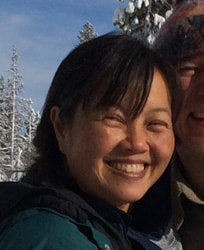Current Students, Research Assistants, Postdocs, and Associates
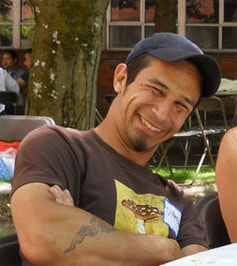
Joe Di Meglio completed his bachelor's degree in botany from OSU in 2019. For a couple of years he led our efforts in building expertise in DNA sequencing in support of taxonomic and ecological projects. Joe has particular interests in fungi (of all kinds), photography, soil-dwelling members of the lichen genus Aspicilia, Sticta and related genera, and anything with a diesel engine in it. He was a principal scientist at Microterra Labs near Corvallis, and now has a Faculty Research Assistant in our department, working for Jessie Uehling. For a complete list of Joe's publications, see Google Scholar.
Smith, R. J., E. Alphandary, R. Arvidson, G. Bono, B. Chipman, A. Corkery, J. Di Meglio, K. Hansen, K. Isch, J. McAlpine, C. Marks-Fife, B. Mead, D. Miller, N. Nolte, A. Ottombrino, T. Prior, J. Streich, S. Theis, S. Vandruff, C. Wesseler, K. Wesseler, M. Wiseman & B. McCune. 2012. Rare inland reindeer lichens at Mima Mounds in southwest Washington State. North American Fungi 7(3): 1-25.
McCune, B., J. Di Meglio & M. J. Curtis. 2014. An unusual ascospore shape and a new species, Umbilicaria nodulospora (Umbilicariaceae), from California and Oregon. Bryologist 117:170-178.
McCune, B., M. J. Curtis & J. Di Meglio. 2017. New taxa and a case of ephemeral spore production in Lecideaceae from western North America. Bryologist 120:115-124.
Simon A., J. Di Meglio, T. Goward, K. Dillman, T. Spribille & B. Goffinet. 2018. Sticta torii sp. nov., a remarkable lichen of high conservation priority from northwestern North America. Graphis Scripta 30: 105–114.
McCune, B. & J. Di Meglio. 2021. Revision of the Aspicilia reptans group in western North America, an important component of soil biocrusts. Monographs in North American Lichenology 5: 1-92.
Smith, R. J., E. Alphandary, R. Arvidson, G. Bono, B. Chipman, A. Corkery, J. Di Meglio, K. Hansen, K. Isch, J. McAlpine, C. Marks-Fife, B. Mead, D. Miller, N. Nolte, A. Ottombrino, T. Prior, J. Streich, S. Theis, S. Vandruff, C. Wesseler, K. Wesseler, M. Wiseman & B. McCune. 2012. Rare inland reindeer lichens at Mima Mounds in southwest Washington State. North American Fungi 7(3): 1-25.
McCune, B., J. Di Meglio & M. J. Curtis. 2014. An unusual ascospore shape and a new species, Umbilicaria nodulospora (Umbilicariaceae), from California and Oregon. Bryologist 117:170-178.
McCune, B., M. J. Curtis & J. Di Meglio. 2017. New taxa and a case of ephemeral spore production in Lecideaceae from western North America. Bryologist 120:115-124.
Simon A., J. Di Meglio, T. Goward, K. Dillman, T. Spribille & B. Goffinet. 2018. Sticta torii sp. nov., a remarkable lichen of high conservation priority from northwestern North America. Graphis Scripta 30: 105–114.
McCune, B. & J. Di Meglio. 2021. Revision of the Aspicilia reptans group in western North America, an important component of soil biocrusts. Monographs in North American Lichenology 5: 1-92.
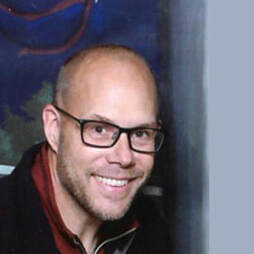
Mike Haldeman has probably visited more Forest Inventory and Analysis plots in Idaho and elsewhere in the Pacific Northwest than anyone. Fortunately for lichenology he has had his eyes open and has found many interesting and elusive species. In addition he redetermined for the FIA Lichen Community indicator many specimens in taxa that have been recently revised. In 2017 he began part-time work with Oregon State University as a key person in the Lichen Herbarium Improvement project. Considering that he has been working full time for most of the year for the Forest Service, he already has an impressive list of publications. For a complete list, see his Google Scholar page. Mike is the central person in our studies of Rhizocarpon in the Pacific Northwest, in particular the yellow species.
Brodo, I. M., M. Haldeman and J. Maliček. 2019. Notes on species of the Lecanora albella group (Lecanoraceae) from North America and Europe. The Bryologist 122(3): 430-450.
Haldeman, M. 2015. First record of Belted Flycatcher Xenotriccus callizonus from Honduras. Cotinga 37: 48-49.
Haldeman, M. 2018. New and interesting records of lichens and lichenicolous fungi from northwestern USA. Evansia 35(1): 24-29.
Haldeman, M. 2019. New and interesting records of lichens and lichenicolous fungi from northwestern USA II. Evansia 36(3): 63-71.
Suija, A., M. Haldeman, E. Zimmerman, U. Braun and P. Diederich. 2019. Phylogenetic placement and lectotypification of Pseudotryblidium neesii (Helotiales, Leotiomycetes). Fungal Systematics and Evolution 5: 139-149.
Haldeman, M. 2020. New and interesting records of lichens and lichenicolous fungi from northwestern USA III. Evansia 37: 71-80.
Haldeman, M. 2020. Corticolous Crustose Lichens on Forest Inventory Plots in Northern Idaho. Monographs in North American Lichenology 4: 1-71.
Haldeman, M. & B. McCune. 2021. Tephromela eviolacea, a new species of Tephromela (Tephromelataceae) lacking a violet hymenium from northwestern North America. Bryologist 124: 230-241.
Haldeman, M. 2021. New and interesting records of lichens and lichenicolous fungi from northwestern USA IV. Evansia 38: 149-158.
Haldeman, M. 2022. New and interesting records of lichens and lichenicolous fungi from northwestern USA V. Evansia 39: 129-137.
Brodo, I. M., M. Haldeman and J. Maliček. 2019. Notes on species of the Lecanora albella group (Lecanoraceae) from North America and Europe. The Bryologist 122(3): 430-450.
Haldeman, M. 2015. First record of Belted Flycatcher Xenotriccus callizonus from Honduras. Cotinga 37: 48-49.
Haldeman, M. 2018. New and interesting records of lichens and lichenicolous fungi from northwestern USA. Evansia 35(1): 24-29.
Haldeman, M. 2019. New and interesting records of lichens and lichenicolous fungi from northwestern USA II. Evansia 36(3): 63-71.
Suija, A., M. Haldeman, E. Zimmerman, U. Braun and P. Diederich. 2019. Phylogenetic placement and lectotypification of Pseudotryblidium neesii (Helotiales, Leotiomycetes). Fungal Systematics and Evolution 5: 139-149.
Haldeman, M. 2020. New and interesting records of lichens and lichenicolous fungi from northwestern USA III. Evansia 37: 71-80.
Haldeman, M. 2020. Corticolous Crustose Lichens on Forest Inventory Plots in Northern Idaho. Monographs in North American Lichenology 4: 1-71.
Haldeman, M. & B. McCune. 2021. Tephromela eviolacea, a new species of Tephromela (Tephromelataceae) lacking a violet hymenium from northwestern North America. Bryologist 124: 230-241.
Haldeman, M. 2021. New and interesting records of lichens and lichenicolous fungi from northwestern USA IV. Evansia 38: 149-158.
Haldeman, M. 2022. New and interesting records of lichens and lichenicolous fungi from northwestern USA V. Evansia 39: 129-137.
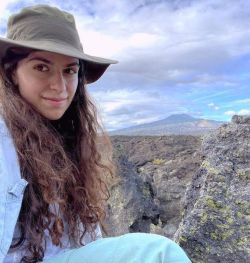
Eleonore Jacobson completed her second undergraduate degree in 2022, this one in Botany at Oregon State. She has worked in the McCune Lab since 2020, developing proficiency in DNA extraction and PCR as well as thin-layer chromatography to detect secondary metabolites. She has applied these skills in our Rhizocarpon project, as well as in other groups of lichens. Eleonore has been a primary person in our studies of elemental content of the epiphytic moss Orthotrichum in the Willamette Valley. Not only is she highly skilled in the lab, she has an unusually large supply of questions... good questions it turns out.
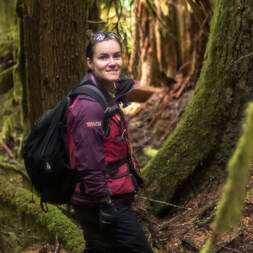
Adrienne Kovasi worked in the field on lichen projects all over the country before beginning grad school in 2019, including lichen community and elemental analysis data for Forest Inventory and Analysis (FIA) program plots and air quality studies. She has distinguished herself by becoming certified in west-side macrolichens by Northwest Lichenologists in 2017. In 2019 she began taking part certifications as a trainer and examiner. Her undergraduate degree is from that hotbed of botanists and cryptogam enthusiasts, Humboldt State University (now Cal Poly) in Arcata, California. After completing her masters in 2022, she resumed working for the US Forest Service in California. Her thesis involved extending methods for indicating lichen air quality from forested areas of the Sierra Nevada to the rocky, treeless high country of the Sierra Nevada.
Jovan, S., M. E. Fenn, M. Buhler, A. Bytnerowicz, A. Kovasi, M. Hutten, E. Di Meglio, D. Schweizer. 2021. Challenges characterizing N deposition to high elevation protected areas: A case study integrating instrument, simulated, and lichen inventory datasets for the Devils Postpile National Monument and surrounding region, USA. Ecological Indicators 122:107311. 12 pages.
Kovasi, A. I. 2022. Lichen Biomonitoring from Valley to Alpine in Central and Southern California. M. S. Thesis, Oregon State University, Department of Botany and Plant Pathology. 78 pages.
Kovasi, A., B. McCune, and S. Jovan. 2022. The potential use of elemental content of saxicolous lichens as bioindicators of nitrogen deposition in the central and southern California mountains. Ecological Indicators 144, https://doi.org/10.1016/j.ecolind.2022.109541
Jovan, S., M. E. Fenn, M. Buhler, A. Bytnerowicz, A. Kovasi, M. Hutten, E. Di Meglio, D. Schweizer. 2021. Challenges characterizing N deposition to high elevation protected areas: A case study integrating instrument, simulated, and lichen inventory datasets for the Devils Postpile National Monument and surrounding region, USA. Ecological Indicators 122:107311. 12 pages.
Kovasi, A. I. 2022. Lichen Biomonitoring from Valley to Alpine in Central and Southern California. M. S. Thesis, Oregon State University, Department of Botany and Plant Pathology. 78 pages.
Kovasi, A., B. McCune, and S. Jovan. 2022. The potential use of elemental content of saxicolous lichens as bioindicators of nitrogen deposition in the central and southern California mountains. Ecological Indicators 144, https://doi.org/10.1016/j.ecolind.2022.109541
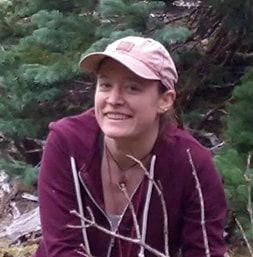
Claire Morris (formerly Claire Whittaker) earned her undergraduate in Botany from OSU in 2019. Since then she has held a variety of botanical jobs in the Corvallis area, including the Hazelnut Research Farm, the McCune lab, the OSU Herbarium, doing lichen plots for the U.S. Forest Service, and working for the Institute of Applied Ecology. She was also instrumental in a study of the hydrologic role of moss mats on rooftops, including interception and hydrobuffering. Currently in the lab she is a key manager of the lichen collection, collection databasing, analysis of secondary metabolites by thin-layer chromatography, and DNA extraction and PCR. She has also taken a primary role in our studies of Punctelia in the Pacific Northwest. And then there are her skills with a fiddle...
Morris, C. & D. F. Stone. 2023. Chaenotheca subroscida and C. phaeocephala in the Pacific Northwest of North America Evansia 40: 3-10.
Morris, C. & D. Stone. 2022. Nephroma orvoi in Western North America. Evansia, 39(2):82-86.. https://doi.org/10.1639/0747-9859-39.2.82
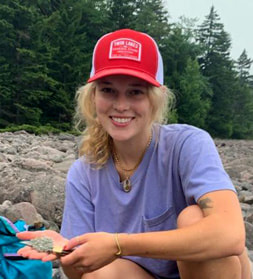
Grace O'Brien was an undergraduate student worker in the McCune lab, double majoring in Botany and Microbiology at OSU. She began work in the McCune lab in 2021 and has been very helpful with our work on chromatography and DNA sequencing of the lichen genus Stereocaulon. Grace is also working on the phylogeography of Stigonema cyanobionts in cephalodia of Stereocaulon. Art, music, science, lichens... what more could you ask for? Grace graduated in 2023 and it will be interesting to see where life takes her.
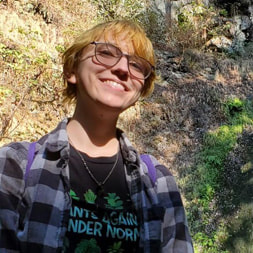
Kathleen (Katie) Phillips is an undergraduate student in Botany and Plant Pathology at OSU. Katie found a love of unusual plants at a young age living in southern California and taking trips to Arizona, subsequently discovering cacti and succulents. After moving to Oregon for college Katie discovered a love of the bountiful non-vascular plants, lichen, and fungi found here in the PNW. Katie began working in the McCune lab in Fall 2022 and has worked on specimen databasing as well as a variety of laboratory tasks, especially thin-layer chromatography. In the summer Katie has worked on plant crews with the Forest Service.
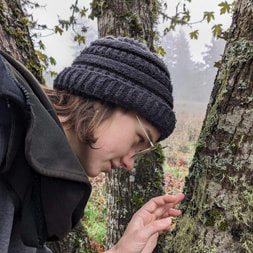
Dale Ruzicka is an undergraduate student in Botany and Plant Pathology at OSU. Dale comes to us with a diverse background including community gardening (Food for Lane County), work for the YCC and Forest Service, and greenhouse work at OSU. A well-kept secret is that Dale is a talented in drawing, recently showcased in a poster on the various reproductive propagules in the lichen genus Platismatia. Dale has gone from 0 to 60 in our lab, producing high quality PCR products for our DNA sequencing projects.
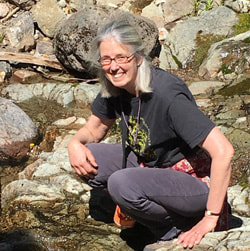
Daphne F. Stone, Faculty Research Assistant, began working for OSU in 2017, but has had a long, distinguished career in lichenology before that. She received her PhD from the University of Oregon in 1986 on "Succession of epiphytes on Quercus garryana branches in the Willamette Valley of western Oregon." She is a long-time president of Northwest Lichenologists. Daphne is the central person in our studies of Leptogium and Scytinium in the Pacific Northwest.
Recent publications:
Morris, C. & D. F. Stone. 2023. Chaenotheca subroscida and C. phaeocephala in the Pacific Northwest of North America Evansia 40: 3-10.
Morris, C. & D. F. Stone. 2022. Nephroma orvoi in Western North America. Evansia, 39(2):82-86. https://doi.org/10.1639/0747-9859-39.2.82
Stone, D. F. & B. McCune. 2022. Two new hairy Leptogium (Collemataceae) species from western North America. Bryologist 125: 157-169.
Stone, D. F., B. McCune, C. J. Pardo-De la Hoz, N. Magain, J. Miadlikowska. 2021. Sinuicella denisonii, a new genus and species in the Peltigeraceae from western North America. Lichenologist 53: 185-192.
Stone, D. F. & H. T. Root. 2021. A Niche For Platismatia Wheeleri. Evansia 38: 137-145.
Stone, D. F. 2018. Usnea in the Pacific Northwest, Aide Memoire. Northwest Lichenologists, Corvallis, Oregon.
Stone, D. F., J. W. Hinds, F. L. Anderson, and J. C. Lendemer. 2016. A revision of the Leptogium saturninum group in North America. Lichenologist 48(5): 387-421.
Villella, J., D. Stone, L. M. Calabria, and G.D. Eide. 2013. Macrolichen Communities of Quercus garryana Dougl. ex Hook in Washington. In press (North American Fungi).
Stone, D., and B. McCune. 2010. Collema quadrifidum, a new epiphytic lichen species from the Pacific Northwest of the United States. North American Fungi 5(2):1-6.
Stone, D., and A. Ruchty. 2008. Leptogium siskiyouensis, a new epiphytic lichen species from the Pacific Northwest of the United States. North American Fungi 3(2):1-7.
Recent publications:
Morris, C. & D. F. Stone. 2023. Chaenotheca subroscida and C. phaeocephala in the Pacific Northwest of North America Evansia 40: 3-10.
Morris, C. & D. F. Stone. 2022. Nephroma orvoi in Western North America. Evansia, 39(2):82-86. https://doi.org/10.1639/0747-9859-39.2.82
Stone, D. F. & B. McCune. 2022. Two new hairy Leptogium (Collemataceae) species from western North America. Bryologist 125: 157-169.
Stone, D. F., B. McCune, C. J. Pardo-De la Hoz, N. Magain, J. Miadlikowska. 2021. Sinuicella denisonii, a new genus and species in the Peltigeraceae from western North America. Lichenologist 53: 185-192.
Stone, D. F. & H. T. Root. 2021. A Niche For Platismatia Wheeleri. Evansia 38: 137-145.
Stone, D. F. 2018. Usnea in the Pacific Northwest, Aide Memoire. Northwest Lichenologists, Corvallis, Oregon.
Stone, D. F., J. W. Hinds, F. L. Anderson, and J. C. Lendemer. 2016. A revision of the Leptogium saturninum group in North America. Lichenologist 48(5): 387-421.
Villella, J., D. Stone, L. M. Calabria, and G.D. Eide. 2013. Macrolichen Communities of Quercus garryana Dougl. ex Hook in Washington. In press (North American Fungi).
Stone, D., and B. McCune. 2010. Collema quadrifidum, a new epiphytic lichen species from the Pacific Northwest of the United States. North American Fungi 5(2):1-6.
Stone, D., and A. Ruchty. 2008. Leptogium siskiyouensis, a new epiphytic lichen species from the Pacific Northwest of the United States. North American Fungi 3(2):1-7.
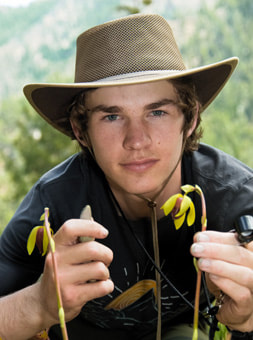
Zane Walker is an undergrad at OSU, is majoring in botany, and works in the McCune lab. Growing up in the Siskiyou/Cascade Range he developed a strong interest in the unique flora of the area. He has worked two seasons as a botanist for the Klamath National Forest identifying and mapping rare plant populations. He is the youngest member of the Siskiyou Field Institute to complete their naturalist certificate program. He is currently collecting for and contributing to an upcoming Bryoflora of the Marble Mountains Wilderness. He prolifically contributes to iNaturalist and seems to be interested in pretty much everything.
|
Sunia Yang in the last few years has grown an interest in lichens and bryophytes and she has long-term interests in plants, birds, and many other things. She now has a chance to cultivate these interests, having retired from a career as a network engineer. Sunia began as a courtesy Faculty Research Assistant at Oregon State University in 2019. She has put her skills with software engineering and user-friendly design to work with the first online interactive key to macrolichens in the Pacific Northwest (see citation below). One of her main goals is to build tools focused data usability. In many fields, the sudden surge of available data has not been matched by enough useful interfaces between humans and that data. She is particularly interested in interactive data visualizations and tools that help people learn about the natural world.
McCune, B. and S. Yang. 2019. Common Macrolichens of the Pacific Northwest. Online interactive key, based on an innovative Bayesian model with fuzzy characters. http://lichens.twinferntech.net/pnw/index.shtml McCune, B., S. Yang, S. Jovan & Heather T. Root. 2022. Climate and epiphytic macrolichen communities in the Four Corners region of the U.S.A. Bryologist 125: 70-90. |
Former Students and Research Assistants
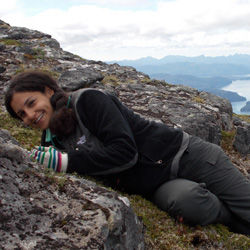
Nijmah Ali graduated with a degree in botany from Humboldt
State University, has worked for the Forest Service in northern California, and
is now working on a masters degree at OSU. Nijmah working on successional
and lichenometric methods for dating prehistoric cairns in the alpine of
coastal southeastern Alaska. Nijmah now teaches at Butte College in California.
McCune, B., N. Ali, R. J. Hartley, and W. J. Hunt. 2017. Estimating age of rock cairns in southeast Alaska by combining evidence from successional metrics, lichenometry, and carbon dating. Arctic Science (in press), https://doi.org/10.1139/AS-2016-0057
State University, has worked for the Forest Service in northern California, and
is now working on a masters degree at OSU. Nijmah working on successional
and lichenometric methods for dating prehistoric cairns in the alpine of
coastal southeastern Alaska. Nijmah now teaches at Butte College in California.
McCune, B., N. Ali, R. J. Hartley, and W. J. Hunt. 2017. Estimating age of rock cairns in southeast Alaska by combining evidence from successional metrics, lichenometry, and carbon dating. Arctic Science (in press), https://doi.org/10.1139/AS-2016-0057
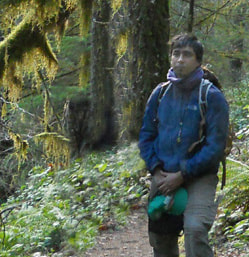
Juan Carlos Benavides worked with us in Oregon while finishing his PhD at Southern Illinois University, working with Dale Vitt. He worked with us on developing rapid and efficient methods for sampling ground-layer bryophytes for the Forest Inventory and Analysis program, such that their contributions to carbon storage, diversity, and cover can be estimated. Originally from Colombia, Juan has worked on bryophytes and peatlands in South America, Puerto Rico, and North America. In addition he works on bryophyte biodiversity and community ecology. Juan is currently at the National University of Colombia, Bogota. See Juan's website for his publications before
coming to OSU.
Smith, R. J., J. C. Benavides, S. Jovan, M. Amacher & B. McCune. 2015. A rapid method for landscape assessment of carbon storage and ecosystem function in moss and lichen ground layers Bryologist 118:32-45. doi: http://dx.doi.org/10.1639/0007-2745-118.1.032
coming to OSU.
Smith, R. J., J. C. Benavides, S. Jovan, M. Amacher & B. McCune. 2015. A rapid method for landscape assessment of carbon storage and ecosystem function in moss and lichen ground layers Bryologist 118:32-45. doi: http://dx.doi.org/10.1639/0007-2745-118.1.032
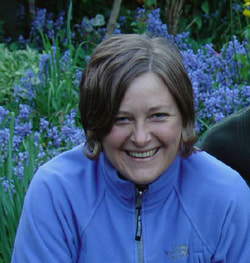
Shanti Berryman did lichen field work for years in the Gifford-Pinchot National Forest before coming to OSU. She studied the biomass and community composition of lichens in different stand structures in the Blue River Landscape Project. These data allowed us to evaluate the long-term consequences of alternative management strategies. Shanti received the Goward Prize at the Northwest Lichen Guild meeting in 2000 and the A. J. Sharp award at the ABLS meeting in 2000. She received her PhD in 2002 and is field-certified in macrolichens west of the Cascade Crest by Northwest Lichenologists. Since her PhD Shanti has worked on lichens and air quality in Alberta, and as a research associate in the Forest Science department at OSU. See Shanti's website.
Berryman, S. D. 2002. Epiphytic macrolichens in relation to forest management and topography in a western Oregon watershed. Ph. D. Dissertation
McCune, B., J. Hutchinson, & S. Berryman. 2002. Concentration of rare epiphytic lichens along large streams in a mountainous watershed in Oregon, U.S.A. Bryologist 105:539-450.
McCune, B., S. D. Berryman, J. H. Cissel, & A. I. Gitelman. 2003. Use of a smoother to forecast occurrence of epiphytic lichens under alternative forest management plans. Ecological Applications 13:1110-1123.
Berryman, S. D. & B. McCune. 2006. Estimating epiphytic macrolichen biomass from topography, stand structure and lichen community data. Journal of Vegetation Science 17:157-170.
Berryman, S. D. & B. McCune. 2006. Epiphytic lichens along gradients in topography and stand structure in western Oregon, USA. Pacific Northwest Fungi 1(2):1-38.
Berryman, S. D. 2002. Epiphytic macrolichens in relation to forest management and topography in a western Oregon watershed. Ph. D. Dissertation
McCune, B., J. Hutchinson, & S. Berryman. 2002. Concentration of rare epiphytic lichens along large streams in a mountainous watershed in Oregon, U.S.A. Bryologist 105:539-450.
McCune, B., S. D. Berryman, J. H. Cissel, & A. I. Gitelman. 2003. Use of a smoother to forecast occurrence of epiphytic lichens under alternative forest management plans. Ecological Applications 13:1110-1123.
Berryman, S. D. & B. McCune. 2006. Estimating epiphytic macrolichen biomass from topography, stand structure and lichen community data. Journal of Vegetation Science 17:157-170.
Berryman, S. D. & B. McCune. 2006. Epiphytic lichens along gradients in topography and stand structure in western Oregon, USA. Pacific Northwest Fungi 1(2):1-38.
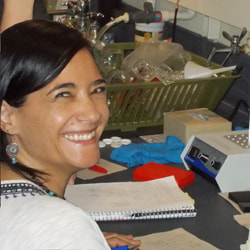
Claudia Corvalán (Claudia Alejandra Corvalán Espinoza) earned her undergraduate degree from the Department of Crop Science at the University of the Americas in Santiago, Chile, and a M.S. in plant protection from the Pontifical Catholic University of Chile. She made herself a valuable and integral part of our lab, with primary responsibilities in DNA extraction and PCR, thin-layer chromatography, and our transplant experiments for studying heavy metal accumulation by mosses. Although her training is primarily in plant pathology, she readily adapted to working on different problems. She has also served as a volunteer with our department's Plant Disease Clinic. In 2022 she returned to Chile to launch a new career there.
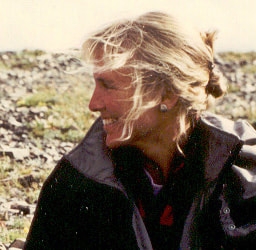
Although Ann DeBolt is great with lichens (see our co-publication on lichens of Glacier National Park in Montana), she chose to do her MS thesis on the distribution and abundance of netleaf hackberry (Celtis reticulata) in Idaho (she finished in 1992). After many years as the district botanist for the BLM and the US Forest Service in Boise, Idaho, she now works for the Idaho Botanical Garden in Boise.
Rosentreter, R., C. Bratt, and A. M. DeBolt. 1988. Curation of soil lichens. Evansia 5(2).
DeBolt, A. M. 1992. The ecology of Celtis reticulata Torr. (netleaf hackberry) in Idaho. M. S. Thesis.
DeBolt, A. and B. McCune. 1993. Lichens of Glacier National Park, Montana. Bryologist 96:192-204.
Rosentreter, R., L. C. Smithman, and A. DeBolt. 1993. Swedish names translated to English. Evansia 10(3):104-111.
DeBolt, A. and B. McCune. 1995. Is netleaf hackberry a viable rehabilitation species for Idaho rangelands? Pp. 305-309 in Proceedings: wildland shrub and arid land restoration symposium. USDA Forest Service General Technical Report INT-GTR-315.
DeBolt, A. and B. McCune. 1995. Ecology of Celtis reticulata in Idaho. Great Basin Naturalist 55:237-248.
Rosentreter, R., C. Bratt, and A. M. DeBolt. 1988. Curation of soil lichens. Evansia 5(2).
DeBolt, A. M. 1992. The ecology of Celtis reticulata Torr. (netleaf hackberry) in Idaho. M. S. Thesis.
DeBolt, A. and B. McCune. 1993. Lichens of Glacier National Park, Montana. Bryologist 96:192-204.
Rosentreter, R., L. C. Smithman, and A. DeBolt. 1993. Swedish names translated to English. Evansia 10(3):104-111.
DeBolt, A. and B. McCune. 1995. Is netleaf hackberry a viable rehabilitation species for Idaho rangelands? Pp. 305-309 in Proceedings: wildland shrub and arid land restoration symposium. USDA Forest Service General Technical Report INT-GTR-315.
DeBolt, A. and B. McCune. 1995. Ecology of Celtis reticulata in Idaho. Great Basin Naturalist 55:237-248.
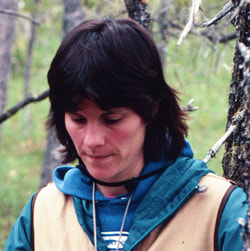
Chiska Derr completed her M.S. thesis in 1994. She studied lichen communities and elemental contents in Pinus contorta bogs in the Tongass National Forest of coastal Alaska. After several years as a district botanist for the Gifford Pinchot National Forest near Mt. St. Helens, Washington, and the National Park Service in southeast Alaska, she worked for NOAA in Alaska. She has been field certified in macrolichens west of the Cascade Crest by Northwest Lichenologists.
Derr, C. C. 1994. Lichen biomonitoring in southeast Alaska and western Oregon. M. S. Thesis. 98 pp.
Geiser, L. H., C. C. Derr, & K. Dillman. 1994a. Air quality monitoring on the Tongass National Forest. Methods and baselines using lichens. USDA Forest Service, Alaska Region Admin. Doc. R10-TB-46. Tongass National Forest, Petersburg, Alaska. 84 pp. + appendices.
Geiser, L. H., K. Dillman, C. C. Derr, & M. C. Stensvold. 1994b. Lichens of southeastern Alaska. An inventory. USDA Forest Service, Alaska Region Admin. Doc. R10-TB-45. Tongass National Forest, Petersburg, Alaska. 145 pp. + appendices.
Geiser, L. H., K. Dillman, C. C. Derr, & M. C. Stensvold. 1998. Lichens and allied fungi of southeast Alaska. Pages 201-243 in M. G. Glenn, R. C. Harris, R. Dirig, & M. S. Cole, editors, Lichenographa Thomsoniana: North American lichenology in honor of John W. Thomson. Mycotaxon, Ithaca, New York, USA.
McCune, B., C. C. Derr, P. S. Muir, A. Shirazi, S. C. Sillett, and W. J. Daly. 1996. Lichen pendants for transplant and growth experiments. Lichenologist 28:161-169.
Derr, C. C., B. McCune & L. H. Geiser . 2007. Epiphytic macrolichen communities in Pinus contorta peatlands in southeastern Alaska. Bryologist 110: 521-532.
Derr, C. C. 1994. Lichen biomonitoring in southeast Alaska and western Oregon. M. S. Thesis. 98 pp.
Geiser, L. H., C. C. Derr, & K. Dillman. 1994a. Air quality monitoring on the Tongass National Forest. Methods and baselines using lichens. USDA Forest Service, Alaska Region Admin. Doc. R10-TB-46. Tongass National Forest, Petersburg, Alaska. 84 pp. + appendices.
Geiser, L. H., K. Dillman, C. C. Derr, & M. C. Stensvold. 1994b. Lichens of southeastern Alaska. An inventory. USDA Forest Service, Alaska Region Admin. Doc. R10-TB-45. Tongass National Forest, Petersburg, Alaska. 145 pp. + appendices.
Geiser, L. H., K. Dillman, C. C. Derr, & M. C. Stensvold. 1998. Lichens and allied fungi of southeast Alaska. Pages 201-243 in M. G. Glenn, R. C. Harris, R. Dirig, & M. S. Cole, editors, Lichenographa Thomsoniana: North American lichenology in honor of John W. Thomson. Mycotaxon, Ithaca, New York, USA.
McCune, B., C. C. Derr, P. S. Muir, A. Shirazi, S. C. Sillett, and W. J. Daly. 1996. Lichen pendants for transplant and growth experiments. Lichenologist 28:161-169.
Derr, C. C., B. McCune & L. H. Geiser . 2007. Epiphytic macrolichen communities in Pinus contorta peatlands in southeastern Alaska. Bryologist 110: 521-532.
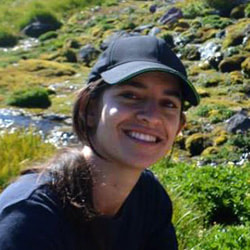
Elisa Di Meglio (formerly Elisa Alphandary) is currently an instructor in the Botany and Plant Pathology Department at OSU, where she teaches online lichenology and many other topics. She obtained her bachelor's degree in botany from OSU in 2012. During that time she worked as a student assistant in my lab. Since then she worked for the Forest Service air quality program and in my lab as a research assistant. For several years she was the central person for thin-layer chromatography in my lab and contributed in numerous ways to various research projects, several of which have led to authorship. In addition Elisa became proficient with DNA extraction and PCR, with special interest in the lichen genus Stereocaulon. She is certified for west-side macrolichens by the Northwest Lichenologists. Elisa completed a masters program in 2019, with co-major professors Alyssa Shiel and me on long term changes in vegetation and lichens in relation to metal deposition along the Red Dog Mine haul road in northern Alaska.
Alphandary, E. & B. McCune. 2013. A new chemical spot test for miriquidic acid. Lichenologist 45:697-699.
Smith, R. J., E. Alphandary, R. Arvidson, G. Bono, B. Chipman, A. Corkery, J. Di Meglio, K. Hansen, K. Isch, J. McAlpine, C. Marks-Fife, B. Mead, D. Miller, N. Nolte, A. Ottombrino, T. Prior, J. Streich, S. Theis, S. Vandruff, C. Wesseler, K. Wesseler, M. Wiseman & B. McCune. 2012. Rare inland reindeer lichens at Mima Mounds in southwest Washington State. North American Fungi 7(3): 1-25.
Jovan, S., M. E. Fenn, M. Buhler, A. Bytnerowicz, A. Kovasi, M. Hutten, E. Di Meglio, D. Schweizer. 2021. Challenges characterizing N deposition to high elevation protected areas: A case study integrating instrument, simulated, and lichen inventory datasets for the Devils Postpile National Monument and surrounding region, USA. Ecological Indicators 122:107311. 12 pages.
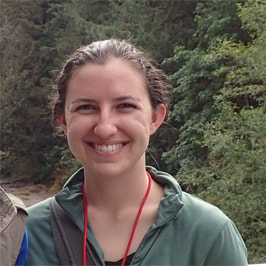
Abby Glauser came to us with an undergraduate degree and herbarium experience at the University of Kansas. Abby was a pivotal person in OSU's NSF-funded project to incorporate a huge number of specimens from the Forest Inventory and Analysis program into the OSU herbarium. Abby worked on lichen community ecology in the Pacific Northwest, in particular comparing macrolichens in the ground layer with epiphytic macrolichens, and along a regional climatic gradient. Since then she took a position as a research assistant at the University of Minnesota, St. Paul.
Glauser, A. 2018. Contrasting Epiphytic and Ground Layer Macrolichen Communities along the Coast-to-inland Climatic Gradient in Oregon. M. S. Thesis, Dept. of Botany and Plant Pathology, Oregon State University.
Glauser, A. 2018. Contrasting Epiphytic and Ground Layer Macrolichen Communities along the Coast-to-inland Climatic Gradient in Oregon. M. S. Thesis, Dept. of Botany and Plant Pathology, Oregon State University.
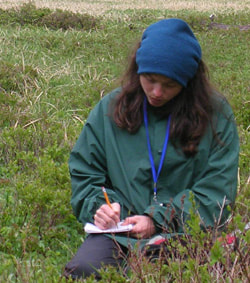
Amanda Hardman has a keen interest in bryophyte and lichen taxonomy and ecology. She began as a graduate student in 2006, after many seasonal jobs as a botanist with federal agencies. Her thesis project concerned responses of soil-dwelling bryophytes to disturbances (fire, logging, and grazing) in dry forests east of the Cascade crest. She also has a special interest in Sphagnum in Oregon. Currently Amanda is employed in botanical survey work and by the U.S. Forest Service.
Hardman, A. 2008. Terrestrial Cryptogam Communities in the Blue Mountains of Northeast Oregon. MS Thesis, Oregon State University.
McCune, B., S. Jovan & A. Hardman. 2008. Changes in forage lichen biomass after insect outbreaks and fuel reduction treatments in the Blue Mountains, Oregon. North American Fungi 3(4): 1-15. doi: 10.2509/naf2008.003.004
Hardman,A. & B. McCune. 2010. Bryoid layer response to soil disturbance by fuel reduction treatments in a dry conifer forest. Bryologist 113:235-245.
Hardman,A. 2010. High Plains Drifter, a vagrant moss discovered in northeast Oregon. Evansia 27:94-99.
Hardman, A. 2008. Terrestrial Cryptogam Communities in the Blue Mountains of Northeast Oregon. MS Thesis, Oregon State University.
McCune, B., S. Jovan & A. Hardman. 2008. Changes in forage lichen biomass after insect outbreaks and fuel reduction treatments in the Blue Mountains, Oregon. North American Fungi 3(4): 1-15. doi: 10.2509/naf2008.003.004
Hardman,A. & B. McCune. 2010. Bryoid layer response to soil disturbance by fuel reduction treatments in a dry conifer forest. Bryologist 113:235-245.
Hardman,A. 2010. High Plains Drifter, a vagrant moss discovered in northeast Oregon. Evansia 27:94-99.
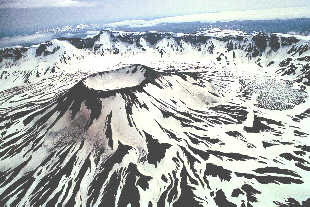
Linda Hasselbach completed her thesis on community ecology in the giant caldera at Aniakchak National Monument in Alaska in 1995. She is one of those people who develops skills at naming everything -- so she included bryophytes, lichens, and vascular plants for her thesis. She was then employed by the National Park Service in Alaska and Washington.
Hasselbach, L. M. 1995. Vascular and nonvascular vegetation of the Caldera of Mt. Aniakchak, Alaska. M. S. Thesis.
Hasselbach, L. M. 1995. Vascular and nonvascular vegetation of Aniakchak Caldera , Alaska. National Biological Service, Forest and Rangeland Ecosystem Science Center, Corvallis, Oregon. Technical Report NPS/PNROSU/NRTR-95/05. 69 pages.
Hasselbach, L. M. & P. Neitlich. 1996. A description of the vegetation of Round Island, Walrus Islands State Game Sanctuary, Alaska. Unpublished report for the National Natural Landmark Program of Alaska, the National Park Service and the Alaska Department of Fish and Game.
National Park Service Photo: Aniakchak Caldera
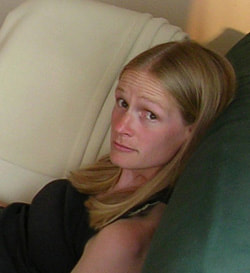
Emily Holt worked on macrolichen communities in northwestern Alaska, in particular Bering Land Bridge National Preserve on the Seward Peninsula and Noatak National Preserve in the western Brooks Range. She came to us with a masters from the University of Wyoming, studying vascular plants, of all things. Emily was the 2005 winner of the Goward Prize for best student or amateur talk at the NW Lichenologists annual meeting. Emily finished her PhD in 2007, taught for several years at Utah Valley University, and now teaches and continues her research at the University of Northern Colorado. See Emily's website.
Holt, E. A. & P. M. Severns. 2005. The effects of prescribed burning on wet prairie lichen communities. Natural Areas Journal 25:130-136.
Holt, E. A., B. McCune & P. Neitlich. 2006. Defining a successional metric for lichen communities in Arctic tundra. Arctic, Antarctic, and Alpine Research 38:373-377.
Holt, E. A., B. McCune, and P. Neitlich. 2007. Succession and community gradients of arctic macrolichens and their relation to substrate, topography, and rockiness. Pacific Northwest Fungi 2(2):1-21.
Holt, E.A., B. McCune and P. Neitlich. 2008. Grazing and fire impacts on macrolichen communities of the Seward Peninsula, Alaska, U.S.A. The Bryologist. 111:68-83.
Holt, E.A., B. McCune and P. Neitlich. 2008. Spatial scale of GIS-derived categorical variables affects their ability to separate sites by community composition. Applied Vegetation Science 11:xxx-xxx. doi: 10.3170/2008-7-18521
Holt, E.A. and G. Bench. 2008. 14C/C measurements support Andreev�s internode method to determine lichen growth rates in Cladonia stygia (Fr.) Ruoss. Lichenologist 40:559-565.
Holt, E.A., B. McCune and P. Neitlich. 2009. Macrolichen communities in relation to soils and vegetation in Noatak National Preserve, Alaska. Botany 87:241-252.
McCune, B., E. Holt, P. Neitlich, T. Ahti and R. Rosentreter. 2009. Macrolichen diversity in Noatak National Preserve, Alaska. North American Fungi 4(4):1-22. doi: 10.2509/naf2009.004.004
Holt, E. A. & Miller, S. W. 2011. Bioindicators: Concepts and Applications. Nature Education Knowledge 2(1):6
Holt, E. A. & P. M. Severns. 2005. The effects of prescribed burning on wet prairie lichen communities. Natural Areas Journal 25:130-136.
Holt, E. A., B. McCune & P. Neitlich. 2006. Defining a successional metric for lichen communities in Arctic tundra. Arctic, Antarctic, and Alpine Research 38:373-377.
Holt, E. A., B. McCune, and P. Neitlich. 2007. Succession and community gradients of arctic macrolichens and their relation to substrate, topography, and rockiness. Pacific Northwest Fungi 2(2):1-21.
Holt, E.A., B. McCune and P. Neitlich. 2008. Grazing and fire impacts on macrolichen communities of the Seward Peninsula, Alaska, U.S.A. The Bryologist. 111:68-83.
Holt, E.A., B. McCune and P. Neitlich. 2008. Spatial scale of GIS-derived categorical variables affects their ability to separate sites by community composition. Applied Vegetation Science 11:xxx-xxx. doi: 10.3170/2008-7-18521
Holt, E.A. and G. Bench. 2008. 14C/C measurements support Andreev�s internode method to determine lichen growth rates in Cladonia stygia (Fr.) Ruoss. Lichenologist 40:559-565.
Holt, E.A., B. McCune and P. Neitlich. 2009. Macrolichen communities in relation to soils and vegetation in Noatak National Preserve, Alaska. Botany 87:241-252.
McCune, B., E. Holt, P. Neitlich, T. Ahti and R. Rosentreter. 2009. Macrolichen diversity in Noatak National Preserve, Alaska. North American Fungi 4(4):1-22. doi: 10.2509/naf2009.004.004
Holt, E. A. & Miller, S. W. 2011. Bioindicators: Concepts and Applications. Nature Education Knowledge 2(1):6
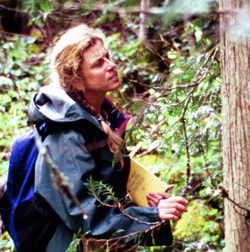
Jenifer Hutchinson completed her M.S. at OSU in 2001. She worked with lichens for years in the Deschutes National Forest in Oregon, before coming to OSU for a Master's degree here at OSU. Her thesis was on riparian lichens on cottonwood (Populus trichocarpa) in northern Idaho. She now works for the Forest Service in Oregon. She is field-certified in macrolichens west of the Cascade Crest by Northwest Lichenologists. Jenifer currently works for the Forest Service in Oregon.
Hutchinson, J. and B. McCune. 2000a. Rare riparian lichens of riparian forests with black cottonwood in northern Idaho. Unpublished Final report to Bureau of Land Management, Boise, and U. S. Forest Service, Coeur d�Alene. 87 pages.
Hutchinson, J. and B. McCune. 2000b. Status of the globally ranked (G1) rare lichen species Collema curtisporum in northern Idaho. Unpublished Final report to Bureau of Land Management, Boise. 19 pages.
Hutchinson, J. 2001. Rare riparian lichens of northern Idaho. M.S.Thesis. 174 pages.
Martin, E., B. McCune, and J. Hutchinson. 2002. Distribution and morphological variation of Leptogium cellulosum and L. teretiusculum in the Pacific Northwest. Bryologist 105:358-362.
McCune, B., J. Hutchinson, and S. Berryman. 2002. Concentration of rare epiphytic lichens along large streams in a mountainous watershed in Oregon, U.S.A. Bryologist 105:539-450.
Hutchinson, J. and B. McCune. 2000a. Rare riparian lichens of riparian forests with black cottonwood in northern Idaho. Unpublished Final report to Bureau of Land Management, Boise, and U. S. Forest Service, Coeur d�Alene. 87 pages.
Hutchinson, J. and B. McCune. 2000b. Status of the globally ranked (G1) rare lichen species Collema curtisporum in northern Idaho. Unpublished Final report to Bureau of Land Management, Boise. 19 pages.
Hutchinson, J. 2001. Rare riparian lichens of northern Idaho. M.S.Thesis. 174 pages.
Martin, E., B. McCune, and J. Hutchinson. 2002. Distribution and morphological variation of Leptogium cellulosum and L. teretiusculum in the Pacific Northwest. Bryologist 105:358-362.
McCune, B., J. Hutchinson, and S. Berryman. 2002. Concentration of rare epiphytic lichens along large streams in a mountainous watershed in Oregon, U.S.A. Bryologist 105:539-450.
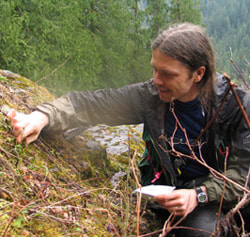
Martin Hutten is an avid bryologist and lichenologist. He has worked for the National Park Service and U.S. Forest Service, taking on the noble work of fighting weeds, promoting biodiversity, and managing forests and people. Martin has worked at Lassen, Olympic, and Yosemite National Parks and at Craters of the Moon, among many other places. He completed a PhD at Oregon State University in 2014, his dissertation entitled, "Yosemite Region Nitrogen Deposition and Patterns in the Composition of Lichen Communities." If you google Martin you will also find that he is a great photographer. He was the lead author and photographer for the hard-to-find pocket guidebook, "101 common mosses, liverworts, and lichens of the Olympic Peninsula." (see below).
Hutten, M., K. Hutten, and A. Woodward. 2001. 101 common mosses, liverworts and lichens of the Olympic Peninsula. Washington DC, U.S. Government Printing Office (out of print).
Hutten, M., A. Woodward, and K. Hutten. 2005. Inventory of the Mosses, Liverworts, Hornworts, and Lichens of Olympic National Park, Washington: Species List. U.S. Dept. Interior Scientific Investigations Report 2005-5240, 78 pp.
Hutten, M., U. Arup, O. Breuss, T. L. Esslinger, A. M. Fryday, K. Knudsen, J. C. Lendemer, C. Printzen, H. T. Root, M. Schultz, J. Sheard, T. Tonsberg, & B. McCune. 2013. Lichens and Lichenicolous Fungi of Yosemite National Park, California. North American Fungi 8(11): 1-47.
Jovan, S., M. E. Fenn, M. Buhler, A. Bytnerowicz, A. Kovasi, M. Hutten, E. Di Meglio, D. Schweizer. 2021. Challenges characterizing N deposition to high elevation protected areas: A case study integrating instrument, simulated, and lichen inventory datasets for the Devils Postpile National Monument and surrounding region, USA. Ecological Indicators 122:107311. 12 pages.
Hutten, M., K. Hutten, and A. Woodward. 2001. 101 common mosses, liverworts and lichens of the Olympic Peninsula. Washington DC, U.S. Government Printing Office (out of print).
Hutten, M., A. Woodward, and K. Hutten. 2005. Inventory of the Mosses, Liverworts, Hornworts, and Lichens of Olympic National Park, Washington: Species List. U.S. Dept. Interior Scientific Investigations Report 2005-5240, 78 pp.
Hutten, M., U. Arup, O. Breuss, T. L. Esslinger, A. M. Fryday, K. Knudsen, J. C. Lendemer, C. Printzen, H. T. Root, M. Schultz, J. Sheard, T. Tonsberg, & B. McCune. 2013. Lichens and Lichenicolous Fungi of Yosemite National Park, California. North American Fungi 8(11): 1-47.
Jovan, S., M. E. Fenn, M. Buhler, A. Bytnerowicz, A. Kovasi, M. Hutten, E. Di Meglio, D. Schweizer. 2021. Challenges characterizing N deposition to high elevation protected areas: A case study integrating instrument, simulated, and lichen inventory datasets for the Devils Postpile National Monument and surrounding region, USA. Ecological Indicators 122:107311. 12 pages.
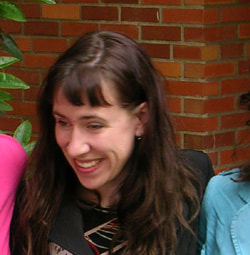
McCune, B., S. Yang, S. Jovan & Heather T. Root. 2022. Climate and epiphytic macrolichen communities in the Four Corners region of the U.S.A. Bryologist 125: 70-90.
Jovan, S., M. E. Fenn, M. Buhler, A. Bytnerowicz, A. Kovasi, M. Hutten, E. Di Meglio, D. Schweizer. 2021. Challenges characterizing N deposition to high elevation protected areas: A case study integrating instrument, simulated, and lichen inventory datasets for the Devils Postpile National Monument and surrounding region, USA. Ecological Indicators 122:107311. 12 pages.Sarah Jovan assisted Andrea Ruchty with her field work for a summer, then worked on various projects, including lichens and fungi, before beginning her graduate program in 2001. During her work with Andrea, she completed a project comparing bark pH of selected tree species in Oregon, and observing the influence of mixed canopies on bark pH. For her PhD thesis (2005), Sarah developed gradient models for communities of epiphytic macrolichens in California. Sarah won the Oregon State University Yerex Award in 2004 and the Goward Prize at the Northwest Lichen Guild Meeting in 2002. Sarah worked for several years on a cooperative project between OSU and the USFS on lichen community data collected in the Pacific coastal states for the FIA program. She now is the National lichen indicator lead for the Forest Inventory and Analysis program, and is stationed in Portland, Oregon.
Selected publications:
Jovan, S. 2002. A landscape-level analysis of epiphytic lichen diversity in northern and central California: environmental predictors of species richness and potential observer effects. Bulletin of the California Lichen Society 9(1):1-7.
Jovan, S. 2002. Air quality in California forests: current efforts to initiate biomonitoring with lichens. Bulletin of the California Lichen Society 9(2):1-5.
Jovan, S. 2003. Distribution and habitat models of epiphytic Physconia in north-central California. Bulletin of the California Lichen Society 10(2):29-35.
Jovan, S. & B. McCune. 2004. Regional variation in epiphytic macrolichen communities in northern and central California forests. Bryologist 107:328-339.
Jovan, S. & B. McCune. 2005. Air-quality bioindication in the greater Central Valley of California, with epiphytic macrolichen communities. Ecological Applications 15:1712-1726.
Jovan, S. & B. McCune. 2006. Using epiphytic macrolichen communities for biomonitoring ammonia in forests of the greater Sierra Nevada, California. Water, Air and Soil Pollution 170:69-93.
Jovan, S. & T. Carlberg. 2007. Nitrogen content of Letharia vulpina tissue from forests of the Sierra Nevada, California: geographic patterns and relationships to ammonia estimates and climate. Environmental Monitorin and Assessment 129: 243-251.
Jovan, S. 2008. Lichen bioindication of biodiversity, air quality, and climate: baseline results from monitoring in Washington, Oregon, and California. USDA Forest Service, General Technical Report PNW-GTR-737.
Fenn, M.E., Jovan, S., Yuan, F., Geiser, L., Meixner, T., & B.S. Gimeno. 2008. Empirical and simulated critical loads for nitrogen deposition in California mixed conifer forests. Environmental Pollution 155: 492-511.
McCune, B., S. Jovan & A. Hardman. 2008. Changes in forage lichen biomass after insect outbreaks and fuel reduction treatments in the Blue Mountains, Oregon. North American Fungi 3(4): 1-15. doi: 10.2509/naf2008.003.004
McCune, B., S. Yang, S. Jovan & Heather T. Root. 2022. Climate and epiphytic macrolichen communities in the Four Corners region of the U.S.A. Bryologist 125: 70-90.
< See further publications at the FIA websites and via Google Scholar. >
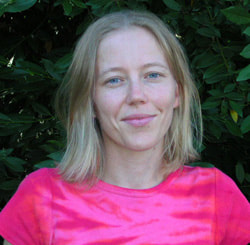
Heather Lintz completed a M.S. in Botany at OSU in 2005, working with Mary Kentula and Mark Wilson. She completed her PhD in 2010. Heather was unusual among my students in not working on lichens; instead, she worked on the basic mathematical properties of species response functions, as applied to tree species distribution in the Pacific coastal states.
Lintz, H. E., M. Huso, K. C. Stanley & T. Taylor. 2010. Composting One Invasive Species to Control Another. Restoration Ecology 19: 1-4.
Lintz, H. E., B. McCune, A. N. Gray, K. A. McCulloh. 2011. Quantifying ecological thresholds from response surfaces. Ecological Modelling 222: 427-436. doi:10.1016/j.ecolmodel.2010.10.017
Lintz, H. E., A. N Gray & B. McCune. 2013. Effect of inventory method on niche models: Random versus systematic error. Ecological Informatics 18:20-34.
Monleon, V. J. & H. E. Lintz. 2015. Evidence of Tree Species’ Range Shifts in a Complex Landscape. PLoS ONE 10(1): e0118069. https://doi.org/10.1371/journal.pone.0118069
Lintz, H. E., M. Huso, K. C. Stanley & T. Taylor. 2010. Composting One Invasive Species to Control Another. Restoration Ecology 19: 1-4.
Lintz, H. E., B. McCune, A. N. Gray, K. A. McCulloh. 2011. Quantifying ecological thresholds from response surfaces. Ecological Modelling 222: 427-436. doi:10.1016/j.ecolmodel.2010.10.017
Lintz, H. E., A. N Gray & B. McCune. 2013. Effect of inventory method on niche models: Random versus systematic error. Ecological Informatics 18:20-34.
Monleon, V. J. & H. E. Lintz. 2015. Evidence of Tree Species’ Range Shifts in a Complex Landscape. PLoS ONE 10(1): e0118069. https://doi.org/10.1371/journal.pone.0118069
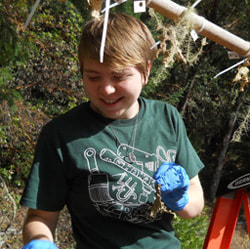
Jade Marks came to us from a background in geosciences at Indiana University, including work on elemental content of lichens in central Montana and laboratory experience with stable isotopes. Jade's primary interest is in biogeochemistry. She obtained a dual degree in Soil Science and Botany, with Julie Pett-Ridge and Bruce McCune as advisors. (See Julie's lab group) Jade completed studies of phosphorus and trace metal effects on both cyanobacterial and green algal lichens.
Marks, J. A. 2015. Interactions between Nitrogen, Phosphorus, and Molybdenum in Forest Soils and Cyanobacterial Lichen in the Oregon Coast Range. M. S. Thesis. Oregon State University, Corvallis.
Marks, J. A., J. C. Pett-Ridge, S. S. Perakis, J. L. Allen, and B. McCune. 2015. Response of the nitrogen-fixing lichen Lobaria pulmonaria to phosphorus, molybdenum, and vanadium. Ecosphere 6:art155. http://dx.doi.org/10.1890/ES15-00140.1
Marks, J. A., S. S. Perakis, E. K. King and J. C. Pett-Ridge. 2015. Soil organic matter regulates molybdenum storage and mobility in forests. Biogeochemistry 125:167-183.
Marks, J. A. 2015. Interactions between Nitrogen, Phosphorus, and Molybdenum in Forest Soils and Cyanobacterial Lichen in the Oregon Coast Range. M. S. Thesis. Oregon State University, Corvallis.
Marks, J. A., J. C. Pett-Ridge, S. S. Perakis, J. L. Allen, and B. McCune. 2015. Response of the nitrogen-fixing lichen Lobaria pulmonaria to phosphorus, molybdenum, and vanadium. Ecosphere 6:art155. http://dx.doi.org/10.1890/ES15-00140.1
Marks, J. A., S. S. Perakis, E. K. King and J. C. Pett-Ridge. 2015. Soil organic matter regulates molybdenum storage and mobility in forests. Biogeochemistry 125:167-183.
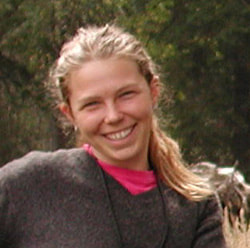
Erin Martin came to Corvallis from Boise State University, where she worked in the lichen herbarium for Roger Rosentreter, in the field with Julie Kaltenecker, and doing her own undergraduate lichen project. She assisted Jenifer Hutchinson in her summer fieldwork in northern Idaho, then became an accomplished TLC artist, working mainly on Hypogymnia with Bruce. Erin completed her PhD in 2005, working on habitat models predicting occurrences of survey-and-manage species on the west slope of the Cascades in Oregon. In 2004 Erin won the A. J. Sharp Award at the American Bryological and Lichenological Society meeting, for best student paper. Since her PhD Erin has taught at Shasta Community College, Pacific University, University of Portland, and University of South Florida.
Martin, E., B. McCune, and J. Hutchinson. 2002. Distribution and morphological variation of Leptogium cellulosum and L. teretiusculum in the Pacific Northwest. Bryologist 105:358-362.
McCune, B., E. P. Martin, and L.-s. Wang. 2003. Five new species of Hypogymnia with rimmed holes from the Chinese Himalayas. Bryologist 106:226-234.
Martin, E. P. 2005. Lichen response to the environment and forest structure in the western Cascades of Oregon. Ph.D. Dissertation, Oregon State University, Corvallis. 169 pages.
Martin, E., B. McCune, and J. Hutchinson. 2002. Distribution and morphological variation of Leptogium cellulosum and L. teretiusculum in the Pacific Northwest. Bryologist 105:358-362.
McCune, B., E. P. Martin, and L.-s. Wang. 2003. Five new species of Hypogymnia with rimmed holes from the Chinese Himalayas. Bryologist 106:226-234.
Martin, E. P. 2005. Lichen response to the environment and forest structure in the western Cascades of Oregon. Ph.D. Dissertation, Oregon State University, Corvallis. 169 pages.
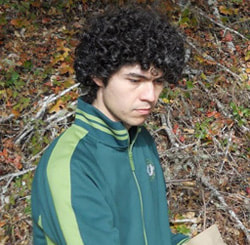
Ricardo Miranda Gonzalez obtained a M.S. degree working on epiphyte community ecology and systematics in a tropical dry forest in Mexico. For his PhD Ricardo pursued the functional roles of high crustose lichen cover in these forests, in particular, their involvement in the food web during the dry season. The lichens are poorly known in this ecosystem, so Ricardo is also contributing detailed studies of the lichen flora of this area. Ricardo held a prestigious CONACYT scholarship. Ricardo completed his degree in 2019, and is now continuing with postdoctoral work in Mexico.
Selected publications:
Barcenas Peña, A., R. Miranda-González, and M. A. Herrera-Campos. 2015. Una peculiar nueva especie de Graphis (Ascomycota: Ostropales: Graphidaceae) de la selva alta perennifolia de Los Tuxtlas, Veracruz, México. Revista Mexicana de Biodiversidad 86(3): 559-564.
Herrera-Campos, M. A., A. Barcenas Peña, R. Miranda-González, M. Altamirano Mejía, J. A. Bautista González, P. Martínez Colín, N. Sánchez Téllez, and R. Lücking. 2019. New lichenized Arthoniales and Ostropales from Mexican seasonally tropical dry forest. Bryologist 122: 62-83.
Miranda-González, R. & B. McCune. 2020. The weight of the crust: Biomass of crustose lichens in tropical dry forest represents more than half of foliar biomass. Biotropica 52: 1298-1308.
Miranda-González, R., R. Lücking, A. Barcenas-Peña, .... 2020. The new genus Jocatoa (Lecanoromycetes: Graphidaceae) and new insights into subfamily Redonographoideae Bryologist 123: 127-143.
Miranda-González, R., A Aptroot, R Lücking, A Flakus, A Barcenas-Peña, M. de los Ángeles Herrera-Campos. 2020. The identity, ecology and distribution of Polypyrenula (Ascomycota: Dothideomycetes): a new member of Trypetheliaceae revealed by molecular and anatomical data. Lichenologist 52: 27-35.
Miranda-Gonzalez, R., B. McCune and A. R. Moldenke. 2022 (2023). Lichens as material for Lepidoptera’s housing: A molecular approach to a widespread and highly selective interaction. Fungal Ecology 61: 101195.
Miranda-González, R., G. Epitacio-Joaquin, A. Tehler, N. Sánchez Téllez, and M. de los Angeles Herrera-Campos. 2022. Roccella ramitumidula (Roccellaceae), a new species from the tropical dry forest of Mexico. Bryologist 125: 479-486. https://doi.org/10.1639/0007-2745-125.3.477
Selected publications:
Barcenas Peña, A., R. Miranda-González, and M. A. Herrera-Campos. 2015. Una peculiar nueva especie de Graphis (Ascomycota: Ostropales: Graphidaceae) de la selva alta perennifolia de Los Tuxtlas, Veracruz, México. Revista Mexicana de Biodiversidad 86(3): 559-564.
Herrera-Campos, M. A., A. Barcenas Peña, R. Miranda-González, M. Altamirano Mejía, J. A. Bautista González, P. Martínez Colín, N. Sánchez Téllez, and R. Lücking. 2019. New lichenized Arthoniales and Ostropales from Mexican seasonally tropical dry forest. Bryologist 122: 62-83.
Miranda-González, R. & B. McCune. 2020. The weight of the crust: Biomass of crustose lichens in tropical dry forest represents more than half of foliar biomass. Biotropica 52: 1298-1308.
Miranda-González, R., R. Lücking, A. Barcenas-Peña, .... 2020. The new genus Jocatoa (Lecanoromycetes: Graphidaceae) and new insights into subfamily Redonographoideae Bryologist 123: 127-143.
Miranda-González, R., A Aptroot, R Lücking, A Flakus, A Barcenas-Peña, M. de los Ángeles Herrera-Campos. 2020. The identity, ecology and distribution of Polypyrenula (Ascomycota: Dothideomycetes): a new member of Trypetheliaceae revealed by molecular and anatomical data. Lichenologist 52: 27-35.
Miranda-Gonzalez, R., B. McCune and A. R. Moldenke. 2022 (2023). Lichens as material for Lepidoptera’s housing: A molecular approach to a widespread and highly selective interaction. Fungal Ecology 61: 101195.
Miranda-González, R., G. Epitacio-Joaquin, A. Tehler, N. Sánchez Téllez, and M. de los Angeles Herrera-Campos. 2022. Roccella ramitumidula (Roccellaceae), a new species from the tropical dry forest of Mexico. Bryologist 125: 479-486. https://doi.org/10.1639/0007-2745-125.3.477
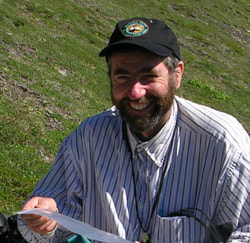
Peter Neitlich was not officially my student, but I worked with him during his masters project out of the University of Vermont and the H. J. Andrews Experimental. Forest. Since then he worked with me on studies for the BLM, including the pioneering work on the importance of hardwoods for epiphytes in otherwise monotonous young conifer forests. He has served as "Indicator Lead" for the Forest Health Monitoring (FHM/FIA) program in western U.S. He now works for the National Park Service in Alaska and Washington.
Neitlich, P. N. 1993. Lichen abundance and biodiversity along a chronosequence from young managed stands to ancient forest. M.S. Thesis, University of Vermont. 90 pages.
Riley, J., B. McCune, and P. Neitlich. 1995. Range extensions of Usnea sphacelata in Oregon and Washington. Evansia 12:24-26.
Sillett, S. C. and P. N. Neitlich. 1996. Emerging themes in epiphyte research in westside forests with special reference to cyanolichens. Northwest Science 70:54-60.
Hasselbach, L. M. & P. Neitlich. 1996. A description of the vegetation of Round Island, Walrus Islands State Game Sanctuary, Alaska. Unpublished report for the National Natural Landmark Program of Alaska, the National Park Service and the Alaska Department of Fish and Game.
Neitlich, P. and B. McCune. 1997. Hotspots of Epiphytic Lichen Diversity in Two Young Managed Forests. Conservation Biology 11:172-182.
McCune, B., J. Dey, J. Peck, D. Cassell, K. Heiman, S. Will-Wolf, and P. Neitlich. 1997. Repeatability of community data: species richness versus gradient scores in large-scale lichen studies. Bryologist 100:40-46.
Holt, E. A., B. McCune & P. Neitlich. 2006. Defining a successional metric for lichen communities in Arctic tundra. Arctic, Antarctic, and Alpine Research 38:373-377.
Holt, E. A., B. McCune, and P. Neitlich. 2007. Succession and community gradients of arctic macrolichens and their relation to substrate, topography, and rockiness. Pacific Northwest Fungi 2(2):1-21.
Holt, E.A., B. McCune and P. Neitlich. 2008. Grazing and fire impacts on macrolichen communities of the Seward Peninsula, Alaska, U.S.A. The Bryologist. 111:68-83.
Holt, E.A., B. McCune and P. Neitlich. 2008. Spatial scale of GIS-derived categorical variables affects their ability to separate sites by community composition. Applied Vegetation Science 11:xxx-xxx. doi: 10.3170/2008-7-18521
Holt, E.A., B. McCune and P. Neitlich. 2009. Macrolichen communities in relation to soils and vegetation in Noatak National Preserve, Alaska. Botany 87:241-252.
McCune, B., E. Holt, P. Neitlich, T. Ahti and R. Rosentreter. 2009. Macrolichen diversity in Noatak National Preserve, Alaska. manuscript.
Root, H., B. McCune & P. Neitlich. 2010. Lichen habitat may be enhanced by thinning treatmetns in young Tsuga heterophylla - Pseudotsuga menziesii forests. Bryologist 113:292-307.
Neitlich, P. N. 1993. Lichen abundance and biodiversity along a chronosequence from young managed stands to ancient forest. M.S. Thesis, University of Vermont. 90 pages.
Riley, J., B. McCune, and P. Neitlich. 1995. Range extensions of Usnea sphacelata in Oregon and Washington. Evansia 12:24-26.
Sillett, S. C. and P. N. Neitlich. 1996. Emerging themes in epiphyte research in westside forests with special reference to cyanolichens. Northwest Science 70:54-60.
Hasselbach, L. M. & P. Neitlich. 1996. A description of the vegetation of Round Island, Walrus Islands State Game Sanctuary, Alaska. Unpublished report for the National Natural Landmark Program of Alaska, the National Park Service and the Alaska Department of Fish and Game.
Neitlich, P. and B. McCune. 1997. Hotspots of Epiphytic Lichen Diversity in Two Young Managed Forests. Conservation Biology 11:172-182.
McCune, B., J. Dey, J. Peck, D. Cassell, K. Heiman, S. Will-Wolf, and P. Neitlich. 1997. Repeatability of community data: species richness versus gradient scores in large-scale lichen studies. Bryologist 100:40-46.
Holt, E. A., B. McCune & P. Neitlich. 2006. Defining a successional metric for lichen communities in Arctic tundra. Arctic, Antarctic, and Alpine Research 38:373-377.
Holt, E. A., B. McCune, and P. Neitlich. 2007. Succession and community gradients of arctic macrolichens and their relation to substrate, topography, and rockiness. Pacific Northwest Fungi 2(2):1-21.
Holt, E.A., B. McCune and P. Neitlich. 2008. Grazing and fire impacts on macrolichen communities of the Seward Peninsula, Alaska, U.S.A. The Bryologist. 111:68-83.
Holt, E.A., B. McCune and P. Neitlich. 2008. Spatial scale of GIS-derived categorical variables affects their ability to separate sites by community composition. Applied Vegetation Science 11:xxx-xxx. doi: 10.3170/2008-7-18521
Holt, E.A., B. McCune and P. Neitlich. 2009. Macrolichen communities in relation to soils and vegetation in Noatak National Preserve, Alaska. Botany 87:241-252.
McCune, B., E. Holt, P. Neitlich, T. Ahti and R. Rosentreter. 2009. Macrolichen diversity in Noatak National Preserve, Alaska. manuscript.
Root, H., B. McCune & P. Neitlich. 2010. Lichen habitat may be enhanced by thinning treatmetns in young Tsuga heterophylla - Pseudotsuga menziesii forests. Bryologist 113:292-307.
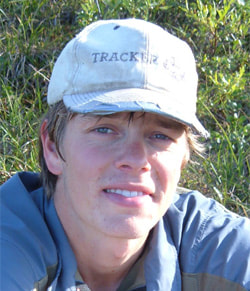
Peter Nelson worked for years with lichens for the Forest Service's Air Resources projects in the Pacific Northwest before beginning grad school. Peter has also worked on developing macrolichen identification resources in both English and Spanish or the Valdivian temperate rainforests of Chile. His PhD thesis project delved into the relationship between caribou and vegetation in Denali National Park, Alaska. This work involved remote sensing and habitat modeling to integrate a vegetation sampling program with caribou location data, with particular emphasis on late-season and winter habitat and snow patterns. He has side interests in Parmelina and Erioderma, among other lichens. Peter began work at University of Maine, Fort Kent, in 2014. See Peter's website.
Nelson, P., J. Walton & C. Roland. 2009. Erioderma pedicellatum (Hue) P.M.Jorg. new to the United States and western North America, discovered in Denali National Park and Preserve and Denali State Park, Alaska. Evansia 26:19-23.
Nelson, P., J. Walton, H. Root & T. Spribille. 2011. Hypogymnia pulverata (Parmeliaceae) and Collema leptaleum (Collemataceae), two macrolichens new to Alaska. North American Fungi 6(7):1-8.
Root, H. T. & P. R. Nelson. 2011. Does phylogenetic distance aid in detecting environmental gradients related to species composition? Journal of Vegetation Science (in press) DOI: 10.1111/j.1654-1103.2011.01320.x
Stehn, S. and P. R. Nelson. 2011. Virtual Tour of the Lichens and Mosses of Denali National Park and Preserve. Murie Science and Learning Center. http://www.nps.gov/features/dena/004/lichens-and-mosses/
Muggia, L., P. Nelson, T. Wheeler, L. S. Yakovchenko, T. T�nsberg, and T. Spribille. 2011. Convergent evolution of a symbiotic duet: The case of the lichen genus Polychidium (Peltigerales, Ascomycota). American Journal of Botany 98: 1647�1656.
Nelson, P.R., Kepler, R., Walton, J., Nelson, L., Fankhauser, J. & L. S. Wang. 2012. Parmelina yalungana resurrected and reported from Alaska, Russia and China. Bryologist 115:557-565.
Nelson, P. R. 2013. Lichen communities and caribou habitat in Denali National Park and Preserve, Alaska, USA. Ph.D. Dissertation, Oregon State University, Corvallis.
Stehn, S., Nelson, P., Roland, C. & J. Jones. 2013 . Patterns in the occupancy and abundance of the globally rare lichen Erioderma pedicellatum in Denali National Park and Preserve, Alaska. Bryologist 116:2-14.
Nelson, P. R, C. Roland, M. J. Macander, and B. McCune. 2013. Detecting continuous lichen abundance for mapping winter caribou forage at landscape spatial scales. Remote Sensing of Environment 137:43-54.
Nelson, P. R. and T. Wheeler. 2013. Cephalodia found on Fuscopannaria viridescens. Lichenologist 45:694-696.
Nelson, P. R, B. McCune, C. Roland, and S. Stehn, S. 2015. Nonparametric methods reveal nonlinear functional trait variation in lichens along environmental and fire age gradients. Journal of Vegetation Science 26:848-865.
Nelson, P. R, McCune, B. & D. Swanson. 2015. Lichen traits and species as indicators of vegetation and environment. Bryologist 118: 252-263.
Nelson, P., J. Walton & C. Roland. 2009. Erioderma pedicellatum (Hue) P.M.Jorg. new to the United States and western North America, discovered in Denali National Park and Preserve and Denali State Park, Alaska. Evansia 26:19-23.
Nelson, P., J. Walton, H. Root & T. Spribille. 2011. Hypogymnia pulverata (Parmeliaceae) and Collema leptaleum (Collemataceae), two macrolichens new to Alaska. North American Fungi 6(7):1-8.
Root, H. T. & P. R. Nelson. 2011. Does phylogenetic distance aid in detecting environmental gradients related to species composition? Journal of Vegetation Science (in press) DOI: 10.1111/j.1654-1103.2011.01320.x
Stehn, S. and P. R. Nelson. 2011. Virtual Tour of the Lichens and Mosses of Denali National Park and Preserve. Murie Science and Learning Center. http://www.nps.gov/features/dena/004/lichens-and-mosses/
Muggia, L., P. Nelson, T. Wheeler, L. S. Yakovchenko, T. T�nsberg, and T. Spribille. 2011. Convergent evolution of a symbiotic duet: The case of the lichen genus Polychidium (Peltigerales, Ascomycota). American Journal of Botany 98: 1647�1656.
Nelson, P.R., Kepler, R., Walton, J., Nelson, L., Fankhauser, J. & L. S. Wang. 2012. Parmelina yalungana resurrected and reported from Alaska, Russia and China. Bryologist 115:557-565.
Nelson, P. R. 2013. Lichen communities and caribou habitat in Denali National Park and Preserve, Alaska, USA. Ph.D. Dissertation, Oregon State University, Corvallis.
Stehn, S., Nelson, P., Roland, C. & J. Jones. 2013 . Patterns in the occupancy and abundance of the globally rare lichen Erioderma pedicellatum in Denali National Park and Preserve, Alaska. Bryologist 116:2-14.
Nelson, P. R, C. Roland, M. J. Macander, and B. McCune. 2013. Detecting continuous lichen abundance for mapping winter caribou forage at landscape spatial scales. Remote Sensing of Environment 137:43-54.
Nelson, P. R. and T. Wheeler. 2013. Cephalodia found on Fuscopannaria viridescens. Lichenologist 45:694-696.
Nelson, P. R, B. McCune, C. Roland, and S. Stehn, S. 2015. Nonparametric methods reveal nonlinear functional trait variation in lichens along environmental and fire age gradients. Journal of Vegetation Science 26:848-865.
Nelson, P. R, McCune, B. & D. Swanson. 2015. Lichen traits and species as indicators of vegetation and environment. Bryologist 118: 252-263.
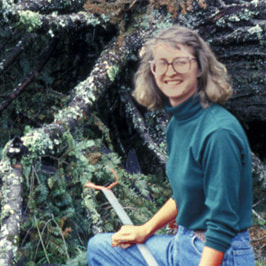
Jeri Peck worked with me for quite a while on diverse array of projects, including being my right arm during the most intense period of activity on Lichen Communities as an indicator in the Forest Health Monitoring program. She completed a masters in 1996 on harvestable moss in western Oregon. She is the most knowledgeable person on this topic in the Pacific Northwest. She has worked on this from all angles, having worked with harvesters, land management agencies, as well as the academic side of biomass accumulation in epiphytic moss mats. See her web pages on commercial moss harvesting in the Pacific Northwest. Jeri received her PhD from the University of Minnesota and is now at Penn State. She regularly offers short courses on PC-ORD and has published a book on the topic.
Peck, J. E., W. S. Hong, and B. McCune. 1995. Diversity of epiphytic bryophytes on four host tree species, Thermal Meadow, Hotsprings Island, Queen Charlotte Islands, Canada. Bryologist 98:123-128.
Peck, J. E. 1995. Autecology of mosses in coniferous forests in the central Washington Cascades of Oregon. Northwest Science 69:184-190.
Peck, J. E. 1996. Harvestable moss: communities, hosts, and accumulation. M. S. Thesis. Oregon State University, Corvallis. 75 pages.
Peck, J. E. and B. McCune. 1997. Moss harvest: what's out there and how fast does it grow? Pages 261-266 in Conservation and Management of Native Flora and Fungi. T. N. Kaye et al., editors. Native Plant Society of Oregon, Corvallis.
McCune, B., J. Dey, J. Peck, D. Cassell, K. Heiman, S. Will-Wolf, P. Neitlich. 1997. Repeatability of community data: species richness versus gradient scores in large-scale lichen studies. Bryologist 100:40-46.
Peck, J. E. 1997. The association of commercially harvestable bryophytes and their host species in northwestern Oregon. Bryologist 100:383-393.
Peck, J. E., & B. McCune. 1997. Effects of green tree retention on epiphytic lichen communities: A retrospective approach. Ecological Applications 7:1181-1187.
Peck, J. E. 1997. Commercial moss harvest in northwestern Oregon: describing the epiphyte communities. Northwest Science 71:186-195.
Peck, J. E. & B. McCune. 1998. Commercial most harvest in northwestern Oregon: biomass and accumulation of epiphytes. Biological Conservation 86:299-305.
Sillett, S. C., B. McCune, J. E. Peck, T. R. Rambo, and A. Ruchty. 2000. Dispersal limitations of epiphytic lichens result in species dependent on old-growth forests. Ecological Applications 10:789-799.
Peck, J. E., J. Ford, B. McCune and W. Daly. 2000. Tethered transplants for estimating biomass growth rates of the Arctic lichen Masonhalea richardsonii. Bryologist 103:449-454.
Sillett, S. C., B. McCune, J. E. Peck, & T. R. Rambo. 2000. Four years of epiphyte colonization in Douglas-fir forest canopies. Bryologist 103:661-669.
Peck, J. E. & P. S. Muir. 2001a. Estimating the biomass of harvestable epiphytic moss in central western Oregon. Northwest Science 75:99-106.
Peck, J. E. & P. S. Muir. 2001b. Harvestable epiphytic bryophytes and their accumulation in central western Oregon. Bryologist 104:181-190.
Peck, J. E. & J. A. Christy. 2006. The stewardship concept in practice: commercial moss harvest in northwestern Oregon, U.S.A. Forest Ecology and Management 225(1-3):225-233.
Peck, J. E. 2006. Regrowth dynamics of understory epiphytic bryophytes 10 years after simulated commercial moss harvest. Canadian Journal of Forest Research, in press.
Peck, J.E. 2006. Towards sustainable commercial moss harvest in the Pacific Northwest of North America. Biological Conservation 28(3):289-297.
Peck, J. E. & P. S. Muir. 2007. Are they harvesting what we think they're harvesting? Comparing field data to commercially sold forest moss. Biodiversity and Conservation 16:2031-2043.
Peck, J.E. & P.S. Muir. 2007. Biomass inventory and regrowth rate of harvestable epiphytic moss in the Oregon Coast Range. Western Journal of Applied Forestry, in press.
Peck, J.E. & L. E. Frelich. 2008. Moss harvest truncates the successional development of epiphytic bryophytes in the Pacific Northwest. Ecological Applications 18:146-158.
Peck, J.E. H. M. Hoganson, P. S. Muir, A. R. Ek, & L. E. Frelich. 2008. Constructing sustainable harvest schedules for the nontimber forest product of epiphytic moss. Forest Science 54(2):185-194.
Studlar, S.M. & J.E. Peck. 2009. Extensive green roofs and mosses: reflections from a pilot study in Terra Alta, West Virginia. Evansia 26(3):52-63.
Peck, J. E. 2010. Multivariate Analysis for Community Ecologists. Step-by-Step Using PC-ORD. MjM Software Design, Gleneden Beach, Oregon.
Peck, [Numerous other publications... see Jeri's website.]
Peck, J. E., W. S. Hong, and B. McCune. 1995. Diversity of epiphytic bryophytes on four host tree species, Thermal Meadow, Hotsprings Island, Queen Charlotte Islands, Canada. Bryologist 98:123-128.
Peck, J. E. 1995. Autecology of mosses in coniferous forests in the central Washington Cascades of Oregon. Northwest Science 69:184-190.
Peck, J. E. 1996. Harvestable moss: communities, hosts, and accumulation. M. S. Thesis. Oregon State University, Corvallis. 75 pages.
Peck, J. E. and B. McCune. 1997. Moss harvest: what's out there and how fast does it grow? Pages 261-266 in Conservation and Management of Native Flora and Fungi. T. N. Kaye et al., editors. Native Plant Society of Oregon, Corvallis.
McCune, B., J. Dey, J. Peck, D. Cassell, K. Heiman, S. Will-Wolf, P. Neitlich. 1997. Repeatability of community data: species richness versus gradient scores in large-scale lichen studies. Bryologist 100:40-46.
Peck, J. E. 1997. The association of commercially harvestable bryophytes and their host species in northwestern Oregon. Bryologist 100:383-393.
Peck, J. E., & B. McCune. 1997. Effects of green tree retention on epiphytic lichen communities: A retrospective approach. Ecological Applications 7:1181-1187.
Peck, J. E. 1997. Commercial moss harvest in northwestern Oregon: describing the epiphyte communities. Northwest Science 71:186-195.
Peck, J. E. & B. McCune. 1998. Commercial most harvest in northwestern Oregon: biomass and accumulation of epiphytes. Biological Conservation 86:299-305.
Sillett, S. C., B. McCune, J. E. Peck, T. R. Rambo, and A. Ruchty. 2000. Dispersal limitations of epiphytic lichens result in species dependent on old-growth forests. Ecological Applications 10:789-799.
Peck, J. E., J. Ford, B. McCune and W. Daly. 2000. Tethered transplants for estimating biomass growth rates of the Arctic lichen Masonhalea richardsonii. Bryologist 103:449-454.
Sillett, S. C., B. McCune, J. E. Peck, & T. R. Rambo. 2000. Four years of epiphyte colonization in Douglas-fir forest canopies. Bryologist 103:661-669.
Peck, J. E. & P. S. Muir. 2001a. Estimating the biomass of harvestable epiphytic moss in central western Oregon. Northwest Science 75:99-106.
Peck, J. E. & P. S. Muir. 2001b. Harvestable epiphytic bryophytes and their accumulation in central western Oregon. Bryologist 104:181-190.
Peck, J. E. & J. A. Christy. 2006. The stewardship concept in practice: commercial moss harvest in northwestern Oregon, U.S.A. Forest Ecology and Management 225(1-3):225-233.
Peck, J. E. 2006. Regrowth dynamics of understory epiphytic bryophytes 10 years after simulated commercial moss harvest. Canadian Journal of Forest Research, in press.
Peck, J.E. 2006. Towards sustainable commercial moss harvest in the Pacific Northwest of North America. Biological Conservation 28(3):289-297.
Peck, J. E. & P. S. Muir. 2007. Are they harvesting what we think they're harvesting? Comparing field data to commercially sold forest moss. Biodiversity and Conservation 16:2031-2043.
Peck, J.E. & P.S. Muir. 2007. Biomass inventory and regrowth rate of harvestable epiphytic moss in the Oregon Coast Range. Western Journal of Applied Forestry, in press.
Peck, J.E. & L. E. Frelich. 2008. Moss harvest truncates the successional development of epiphytic bryophytes in the Pacific Northwest. Ecological Applications 18:146-158.
Peck, J.E. H. M. Hoganson, P. S. Muir, A. R. Ek, & L. E. Frelich. 2008. Constructing sustainable harvest schedules for the nontimber forest product of epiphytic moss. Forest Science 54(2):185-194.
Studlar, S.M. & J.E. Peck. 2009. Extensive green roofs and mosses: reflections from a pilot study in Terra Alta, West Virginia. Evansia 26(3):52-63.
Peck, J. E. 2010. Multivariate Analysis for Community Ecologists. Step-by-Step Using PC-ORD. MjM Software Design, Gleneden Beach, Oregon.
Peck, [Numerous other publications... see Jeri's website.]
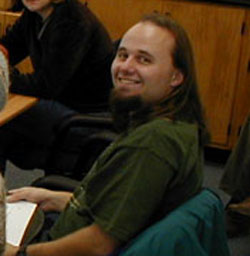
Eric Peterson studied lichen distribution and abundance in relationship to forest structure and management, modelling the probability of species occurrences at the landscape level, and ecology and systematics of calicioid fungi and lichens. Eric received the Goward Prize at the Northwest Lichen Guild meeting (1998). Since his PhD, Eric has worked for the Natural Heritage program in Nevada, the California Native Plant Society, and the U.S. Bureau of Reclamation in Weaverville, California.
McCune, B., K. A. Amsberry, F. J. Camacho, S. Clery, C. Cole, C. Emerson, G. Felder, P. French, D. Greene, R. Harris, M. Hutten, B. Larson, M. Lesko, S. Majors, T. Markwell, G. G. Parker, K. Pendergrass, E. B. Peterson, E. T. Peterson, J. Platt, J. Proctor, T. Rambo, A. Rosso, D. Shaw, R. Turner, and M. Widmer. 1997. Vertical Profile of Epiphytes in a Pacific Northwest Old-growth Forest. Northwest Science 71:145-152.
Peterson, E. B., D. Greene, B. McCune, E. T. Peterson, M. A. Hutten, P. Weisberg, and R. Rosentreter. 1998. Sulcaria badia, a Rare Lichen in North America. Bryologist 101:112-115.
Peterson, E. B. 1998. Lichens in the Klamath Region: What do we know and why have we not found endemics? Pages 120-126 in J. K. Beigel, E. S. Jules, and B. Snitkin, editors, Proceedings of the First Conference on Siskiyou Ecology. May 30-June1, 1997, Kerby and Cave Junction, Oregon. Siskiyou Regional Education Project, Cave Junction.
Peterson, E. B. and J. Rikkinen. 1998. Stenocybe fragmenta, a new species of Mycocaliciaceae with fragmenting spores. Mycologia 90:1087-1090.
Peterson, E. B., J. Platt, and G. Poinar. 1999. Lichens from Dominican Amber. in press.
Peterson, E. B. 2000. Analysis and prediction of patterns in lichen communities over the western Oregon landscape. Ph.D. Dissertation. 140 pages.
Peterson, E. B., & B. McCune. 2001a. Diversity and succession of epiphytic macrolichen communities in low-elevation managed conifer forests in western Oregon. Journal of Vegetation Science 12:511-524.
Peterson, E. B. & B. McCune 2001b. Environmental relations of calicioid lichens and fungi in a temperate landscape. ms.
Peterson, E. B., B. McCune, and J. Rikkinen. 2001c. Modeling occurrence over a landscape for multiple, poorly understood species. ms.
Peterson, E. B. & B. McCune. 2003. The importance of hotspots for lichen diversity in forests of western Oregon. Bryologist 106:246-256.
McCune, B., K. A. Amsberry, F. J. Camacho, S. Clery, C. Cole, C. Emerson, G. Felder, P. French, D. Greene, R. Harris, M. Hutten, B. Larson, M. Lesko, S. Majors, T. Markwell, G. G. Parker, K. Pendergrass, E. B. Peterson, E. T. Peterson, J. Platt, J. Proctor, T. Rambo, A. Rosso, D. Shaw, R. Turner, and M. Widmer. 1997. Vertical Profile of Epiphytes in a Pacific Northwest Old-growth Forest. Northwest Science 71:145-152.
Peterson, E. B., D. Greene, B. McCune, E. T. Peterson, M. A. Hutten, P. Weisberg, and R. Rosentreter. 1998. Sulcaria badia, a Rare Lichen in North America. Bryologist 101:112-115.
Peterson, E. B. 1998. Lichens in the Klamath Region: What do we know and why have we not found endemics? Pages 120-126 in J. K. Beigel, E. S. Jules, and B. Snitkin, editors, Proceedings of the First Conference on Siskiyou Ecology. May 30-June1, 1997, Kerby and Cave Junction, Oregon. Siskiyou Regional Education Project, Cave Junction.
Peterson, E. B. and J. Rikkinen. 1998. Stenocybe fragmenta, a new species of Mycocaliciaceae with fragmenting spores. Mycologia 90:1087-1090.
Peterson, E. B., J. Platt, and G. Poinar. 1999. Lichens from Dominican Amber. in press.
Peterson, E. B. 2000. Analysis and prediction of patterns in lichen communities over the western Oregon landscape. Ph.D. Dissertation. 140 pages.
Peterson, E. B., & B. McCune. 2001a. Diversity and succession of epiphytic macrolichen communities in low-elevation managed conifer forests in western Oregon. Journal of Vegetation Science 12:511-524.
Peterson, E. B. & B. McCune 2001b. Environmental relations of calicioid lichens and fungi in a temperate landscape. ms.
Peterson, E. B., B. McCune, and J. Rikkinen. 2001c. Modeling occurrence over a landscape for multiple, poorly understood species. ms.
Peterson, E. B. & B. McCune. 2003. The importance of hotspots for lichen diversity in forests of western Oregon. Bryologist 106:246-256.
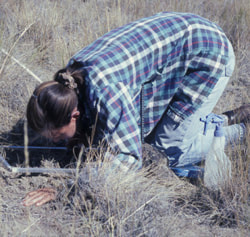
Jeanne Ponzetti, the first Queen of the biotic crusts of eastern Oregon and Washington, was unusual in having chosen to work in the steppe. She completed her thesis on the relationships of grazing, climate, and soils on biotic crusts in Oregon. Immediately after her thesis she studied the distribution, abundance, and composition of biotic crusts at Horse Heaven Hills near Kennewick, Washington. Since her time at OSU she has worked as a botanist for the BLM in Eugene, Oregon, and Ellensburg, Washington. She is now a free-lance editor and botanical consultant working from Olympia, Washington.
Ponzetti, J. M., B. Youtie, D. Salzer, and T. Kimes. 1998. The effects of fir and herbicides on microbiotic crust dynamics in high desert ecosystems. Unpublished report to USGS Biological Resources Division, Corvallis, Oregon. 89 pp.
Ponzetti, J. M., B. Youtie, and D. Salzer. 1999. Recovery of microbiotic soil crusts after prescribed fire: final report. Unpublished report to USGS Biological Resources Division, Corvallis, Oregon. 46 pp.
Youtie, B. J. Ponzetti & D. Salzer. 1999. Fire and herbicides for exotic annual grass control: effects on native plants and
microbiotic soil organisms. VIth International Rangeland Congress Proceedings Vol. 2 590-591. Townsville, Queensland, Australia July 19-23, 1999.
Ponzetti, J. M. 2000. Biotic soil crusts of Oregon's shrub steppe. M.S. Thesis. 112 pp.
McCune, B., R. Rosentreter, J. M. Ponzetti, and D. C. Shaw. 2000. Epiphyte habitats in an old conifer forest in western Washington, USA. Bryologist 103:417-427.
Ponzetti, J. M., B. McCune, and D. Pyke. 2000. Biotic Crusts on a Central Washington Landscape. Final report to the USGS Biological Resources Division, Forest and Rangeland Ecosystem Science Center (FRESC), 48 pages.
Ponzetti, J. M. and B. McCune. 2001. Biotic soil crusts of Oregon's shrub steppe: community composition in relation to soil chemistry, climate, and livestock activity. Bryologist 104:212-225.
McCune, B, F. Camacho, and J. Ponzetti. 2002. Three new species of Trapeliopsis on soil in western North America. Bryologist 105:78-85.
McCune, B. & J. Ponzetti. 2005. Cercidospora soror and Rhizocarpon malenconianum from North America. Evansia 22:6-12.
Ponzetti, J. M. and B. McCune. 2006. A new species of Bactrospora from northwestern North America. Bryologist 109:85-88.
Ponzetti, J., B. McCune & D. A. Pyke. 2007. Biotic soil crusts in relation to topography, cheatgrass and fire in the Columbia Basin, Washington. Bryologist 110: 706-722.
Ponzetti, J. M., B. Youtie, D. Salzer, and T. Kimes. 1998. The effects of fir and herbicides on microbiotic crust dynamics in high desert ecosystems. Unpublished report to USGS Biological Resources Division, Corvallis, Oregon. 89 pp.
Ponzetti, J. M., B. Youtie, and D. Salzer. 1999. Recovery of microbiotic soil crusts after prescribed fire: final report. Unpublished report to USGS Biological Resources Division, Corvallis, Oregon. 46 pp.
Youtie, B. J. Ponzetti & D. Salzer. 1999. Fire and herbicides for exotic annual grass control: effects on native plants and
microbiotic soil organisms. VIth International Rangeland Congress Proceedings Vol. 2 590-591. Townsville, Queensland, Australia July 19-23, 1999.
Ponzetti, J. M. 2000. Biotic soil crusts of Oregon's shrub steppe. M.S. Thesis. 112 pp.
McCune, B., R. Rosentreter, J. M. Ponzetti, and D. C. Shaw. 2000. Epiphyte habitats in an old conifer forest in western Washington, USA. Bryologist 103:417-427.
Ponzetti, J. M., B. McCune, and D. Pyke. 2000. Biotic Crusts on a Central Washington Landscape. Final report to the USGS Biological Resources Division, Forest and Rangeland Ecosystem Science Center (FRESC), 48 pages.
Ponzetti, J. M. and B. McCune. 2001. Biotic soil crusts of Oregon's shrub steppe: community composition in relation to soil chemistry, climate, and livestock activity. Bryologist 104:212-225.
McCune, B, F. Camacho, and J. Ponzetti. 2002. Three new species of Trapeliopsis on soil in western North America. Bryologist 105:78-85.
McCune, B. & J. Ponzetti. 2005. Cercidospora soror and Rhizocarpon malenconianum from North America. Evansia 22:6-12.
Ponzetti, J. M. and B. McCune. 2006. A new species of Bactrospora from northwestern North America. Bryologist 109:85-88.
Ponzetti, J., B. McCune & D. A. Pyke. 2007. Biotic soil crusts in relation to topography, cheatgrass and fire in the Columbia Basin, Washington. Bryologist 110: 706-722.
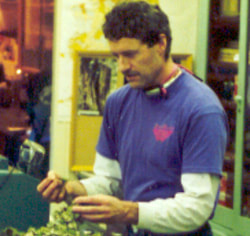
Tom Rambo was not really my student (he was Pat Muir's), but I've worked with Tom a lot so it seems like he's part of this list. Tom's forte is forest floor and epiphytic bryophytes, but he's also good with lichens. He's also a top-notch tree climber (though he points out this is "ascending" not "climbing"). Tom finished his Master's thesis in 1998. Tom completed a PhD at UC Davis in California, where he is currently a post-doctoral researcher.
McCune, B., K. A. Amsberry, F. J. Camacho, S. Clery, C. Cole, C. Emerson, G. Felder, P. French, D. Greene, R. Harris, M. Hutten, B. Larson, M. Lesko, S. Majors, T. Markwell, G. G. Parker, K. Pendergrass, E. B. Peterson, E. T. Peterson, J. Platt, J. Proctor, T. Rambo, A. Rosso, D. Shaw, R. Turner, and M. Widmer. 1997. Vertical Profile of Epiphytes in a Pacific Northwest Old-growth Forest. Northwest Science 71:145-152.
Rambo, T. R. & P. S. Muir. 1998. Forest floor bryophytes of Pseudotsuga menziesii - Tsuga heterophylla stands in Oregon: influences of substrate and overstory. Bryologist 101:116-130.
Rambo, T. R. and P. S. Muir. 1998. Bryophyte species associations with coarse woody debris and stand ages in Oregon. Bryologist 101:366-376.
Sillett, S. C. and T. R. Rambo. 2000. Vertical distribution of dominant epiphytes in Douglas-fir forests of the central Oregon Cascades. Northwest Science 74:44-49.
Rosso, A. L., B. McCune, T. R. Rambo. 2000. Ecology and conservation of a rare, old-growth-associated canopy lichen in a silvicultural landscape. Bryologist 103:117-127.
Sillett, S. C., B. McCune, J. E. Peck, T. R. Rambo, and A. Ruchty. 2000. Dispersal limitations of epiphytic lichens result in species dependent on old-growth forests. Ecological Applications 10:789-799.
Sillett, S. C., B. McCune, J. E. Peck, & T. R. Rambo. 2000. Four years of epiphyte colonization in Douglas-fir forest canopies. Bryologist 103:661-669.
Rosso, A.L., P.S. Muir, & T.R. Rambo. 2001. Using transplants to measure accumulation rates of epiphytic bryophytes in forests of western Oregon. Bryologist 104:430-439.
Rambo, T.R. 2001. Decaying logs and habitat heterogeneity: implications for bryophyte diversity in western Oregon forests. Northwest Science 75:269-278.
Muir, P.S., T.R. Rambo, R.W. Kimmerer, & D.B. Keon. 2006. Influence of overstory removal on growth of epiphytic mosses and lichens in western Oregon. Ecological Applications 16:1207-1221.
McCune, B., K. A. Amsberry, F. J. Camacho, S. Clery, C. Cole, C. Emerson, G. Felder, P. French, D. Greene, R. Harris, M. Hutten, B. Larson, M. Lesko, S. Majors, T. Markwell, G. G. Parker, K. Pendergrass, E. B. Peterson, E. T. Peterson, J. Platt, J. Proctor, T. Rambo, A. Rosso, D. Shaw, R. Turner, and M. Widmer. 1997. Vertical Profile of Epiphytes in a Pacific Northwest Old-growth Forest. Northwest Science 71:145-152.
Rambo, T. R. & P. S. Muir. 1998. Forest floor bryophytes of Pseudotsuga menziesii - Tsuga heterophylla stands in Oregon: influences of substrate and overstory. Bryologist 101:116-130.
Rambo, T. R. and P. S. Muir. 1998. Bryophyte species associations with coarse woody debris and stand ages in Oregon. Bryologist 101:366-376.
Sillett, S. C. and T. R. Rambo. 2000. Vertical distribution of dominant epiphytes in Douglas-fir forests of the central Oregon Cascades. Northwest Science 74:44-49.
Rosso, A. L., B. McCune, T. R. Rambo. 2000. Ecology and conservation of a rare, old-growth-associated canopy lichen in a silvicultural landscape. Bryologist 103:117-127.
Sillett, S. C., B. McCune, J. E. Peck, T. R. Rambo, and A. Ruchty. 2000. Dispersal limitations of epiphytic lichens result in species dependent on old-growth forests. Ecological Applications 10:789-799.
Sillett, S. C., B. McCune, J. E. Peck, & T. R. Rambo. 2000. Four years of epiphyte colonization in Douglas-fir forest canopies. Bryologist 103:661-669.
Rosso, A.L., P.S. Muir, & T.R. Rambo. 2001. Using transplants to measure accumulation rates of epiphytic bryophytes in forests of western Oregon. Bryologist 104:430-439.
Rambo, T.R. 2001. Decaying logs and habitat heterogeneity: implications for bryophyte diversity in western Oregon forests. Northwest Science 75:269-278.
Muir, P.S., T.R. Rambo, R.W. Kimmerer, & D.B. Keon. 2006. Influence of overstory removal on growth of epiphytic mosses and lichens in western Oregon. Ecological Applications 16:1207-1221.
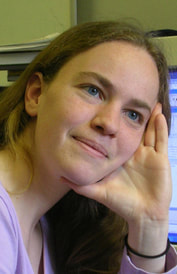
Heather Root came to us from SUNY - Syracuse, where she earned a masters studying epiphytes and invertebrates in relation to silviculture in the Adirondack Mountains. Heather obtained an MS in Statistics and a PhD in Botany at OSU. Her projects in Oregon include comparing statistical power of nonparametric methods for testing multivariate differences among groups with community data, evaluating lichen and bryophyte responses to forest thinning (remeasuring and analyzing lichen communities after 13 years of the Density Management Study), a regional study of epiphytic lichens in relation to climate and air quality in southeast Alaska, evaluating relationships between biological soil crust lichens and environment in eastern Oregon, and exploring the fundamental properties of community data. Heather's 2011 paper on soil crusts, with Miller and McCune, won the 2012 Tuckerman Award from the American Bryological and Lichenological Society. Since completing her PhD, Heather has worked for the BLM, the US Forest Service, and Oregon State University. Beginning in 2014 she works in the Botany Department at Weber State University in Utah. See Heather's website.
Dirig, R. & H. T. Root. 2003. Lichens of the McLean bogs basin near Ithaca, New York. Mycotaxon 87: 329-350.
Root, H. T., A. Y. Kawahara, & R. A. Norton. 2007. Anachipteria sacculifera n. sp. (Acari: Oribatida: Achipteriidae) from arboreal lichens in New York State. Acarologia. 47:173-181.
Root, H.T., G. G. McGee, & R. D. Nyland. 2007. Effects of two silvicultural regimes with large tree retention on epiphytic lichen communities in Adirondack northern hardwoods, New York, USA. Canadian Journal of Forest Research 37: 1854-1866.
Root, H. T., G. G. McGee, & R. A. Norton. 2007. Arboreal Mite Communities on Epiphytic Lichens of the Adirondack Mountains of New York, USA. Northeastern Naturalist 14 (3): 425-438.
Root, H. T., B. McCune & P. Neitlich. 2010. Lichen habitat may be enhanced by thinning treatments in young Tsuga heterophylla - Pseudotsuga menziesii forests. Bryologist 113:292-307.
Root, H. T. & B. McCune. 2010. Forest floor lichen and bryophyte communities in thinned young Tsuga-Pseudotsuga forests of Oregon, Bryologist 113:619-630.
Nelson, P., J. Walton, H. Root & T. Spribille. 2011. Hypogymnia pulverata (Parmeliaceae) and Collema leptaleum (Collemataceae), two macrolichens new to Alaska. North American Fungi 6(7):1-8.
Root, H. T. & P. R. Nelson. 2011. Does phylogenetic distance aid in detecting environmental gradients related to species composition? Journal of Vegetation Science (in press) DOI: 10.1111/j.1654-1103.2011.01320.x
McCune, B., C. Schoch, H. T. Root, S. A. Kageyama & J. Miadlikowska. 2011. Geographic, climatic, and chemical differentiation in the Hypogymnia imshaugii species complex (Parmeliaceae). Bryologist 114:526-544. doi:10.1639/0007-2745-114.3.526
Root, H. T., J. E. D. Miller & B. McCune. 2011. Biotic soil crust lichen diversity and conservation in shrub-steppe habitats of Oregon and Washington. Bryologist 114:796-812.
Root, H. T. & B. McCune. 2011. Regional patterns of biological soil crust lichen species composition related to vegetation, soils, and climate in Oregon, USA. Journal of Arid Environments 79:93-100.
Root, H. T. & B. McCune. 2012. Surveying for biotic soil crust lichens of shrub steppe habitats in the Columbia Basin. North American Fungi 7(7): 1-21.
Root, H. T., M. McCune & B. McCune. 2013. Wind farm potential is higher in prime habitat for uncommon soil crust lichens. Ecological Processes 2:10 1-8.
Root, H. T., B. McCune & Sarah Jovan. 2014. Lichen communities and species indicate climate thresholds in southeast and south-central Alaska, USA. Bryologist 117:241-252.
McCune, B. & H. T. Root. 2015. Origin of the dust bunny distribution in ecological community data. Plant Ecology 216: 645-656. --- Supplemental materials
McCune, B., S. Yang, S. Jovan & H. T. Root. 2022. Climate and epiphytic macrolichen communities in the Four Corners region of the U.S.A. Bryologist 125: 70-90.
[See further publications at Google Scholar]
Dirig, R. & H. T. Root. 2003. Lichens of the McLean bogs basin near Ithaca, New York. Mycotaxon 87: 329-350.
Root, H. T., A. Y. Kawahara, & R. A. Norton. 2007. Anachipteria sacculifera n. sp. (Acari: Oribatida: Achipteriidae) from arboreal lichens in New York State. Acarologia. 47:173-181.
Root, H.T., G. G. McGee, & R. D. Nyland. 2007. Effects of two silvicultural regimes with large tree retention on epiphytic lichen communities in Adirondack northern hardwoods, New York, USA. Canadian Journal of Forest Research 37: 1854-1866.
Root, H. T., G. G. McGee, & R. A. Norton. 2007. Arboreal Mite Communities on Epiphytic Lichens of the Adirondack Mountains of New York, USA. Northeastern Naturalist 14 (3): 425-438.
Root, H. T., B. McCune & P. Neitlich. 2010. Lichen habitat may be enhanced by thinning treatments in young Tsuga heterophylla - Pseudotsuga menziesii forests. Bryologist 113:292-307.
Root, H. T. & B. McCune. 2010. Forest floor lichen and bryophyte communities in thinned young Tsuga-Pseudotsuga forests of Oregon, Bryologist 113:619-630.
Nelson, P., J. Walton, H. Root & T. Spribille. 2011. Hypogymnia pulverata (Parmeliaceae) and Collema leptaleum (Collemataceae), two macrolichens new to Alaska. North American Fungi 6(7):1-8.
Root, H. T. & P. R. Nelson. 2011. Does phylogenetic distance aid in detecting environmental gradients related to species composition? Journal of Vegetation Science (in press) DOI: 10.1111/j.1654-1103.2011.01320.x
McCune, B., C. Schoch, H. T. Root, S. A. Kageyama & J. Miadlikowska. 2011. Geographic, climatic, and chemical differentiation in the Hypogymnia imshaugii species complex (Parmeliaceae). Bryologist 114:526-544. doi:10.1639/0007-2745-114.3.526
Root, H. T., J. E. D. Miller & B. McCune. 2011. Biotic soil crust lichen diversity and conservation in shrub-steppe habitats of Oregon and Washington. Bryologist 114:796-812.
Root, H. T. & B. McCune. 2011. Regional patterns of biological soil crust lichen species composition related to vegetation, soils, and climate in Oregon, USA. Journal of Arid Environments 79:93-100.
Root, H. T. & B. McCune. 2012. Surveying for biotic soil crust lichens of shrub steppe habitats in the Columbia Basin. North American Fungi 7(7): 1-21.
Root, H. T., M. McCune & B. McCune. 2013. Wind farm potential is higher in prime habitat for uncommon soil crust lichens. Ecological Processes 2:10 1-8.
Root, H. T., B. McCune & Sarah Jovan. 2014. Lichen communities and species indicate climate thresholds in southeast and south-central Alaska, USA. Bryologist 117:241-252.
McCune, B. & H. T. Root. 2015. Origin of the dust bunny distribution in ecological community data. Plant Ecology 216: 645-656. --- Supplemental materials
McCune, B., S. Yang, S. Jovan & H. T. Root. 2022. Climate and epiphytic macrolichen communities in the Four Corners region of the U.S.A. Bryologist 125: 70-90.
[See further publications at Google Scholar]
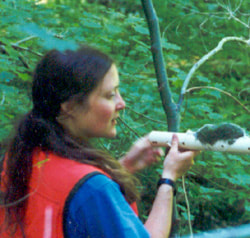
Abbey Rosso finished a Ph.D. project studying epiphytes on shrubs in forests in western Oregon. In addition to collecting lichens, she also collected awards, including the Oregon Sports Scholarship (1996), the Yerex Scholarship (1997), and the Goward Prize at the Northwest Lichen Guild meeting (1997). She was field-certified in macrolichens west of the Cascade Crest by Northwest Lichenologists.
McCune, B., K. A. Amsberry, F. J. Camacho, S. Clery, C. Cole, C. Emerson, G. Felder, P. French, D. Greene, R. Harris, M. Hutten, B. Larson, M. Lesko, S. Majors, T. Markwell, G. G. Parker, K. Pendergrass, E. B. Peterson, E. T. Peterson, J. Platt, J. Proctor, T. Rambo, A. Rosso, D. Shaw, R. Turner, and M. Widmer. 1997. Vertical Profile of Epiphytes in a Pacific Northwest Old-growth Forest. Northwest Science 71:145-152.
Rosso, A. L., B. McCune, T. Tonsberg, and C. Printzen. 1999. Lichens of an old-growth forest in a little-explored area of western Oregon, U.S.A. Evansia 16:137-142.
Rosso, A. L., B. McCune, T. R. Rambo. 2000. Ecology and conservation of a rare, old-growth-associated canopy lichen in a silvicultural landscape. Bryologist 103:117-127.
Rosso, A. L. 2000. Shrub epiphyte communities in relation to stand management in forests of western Oregon. Ph.D. Dissertation, Oregon State University. 125 pages + xv. Download pdf.
Rosso, A. L., P. S. Muir, and B. McCune. 2001. Shrub epiphyte communities in relation to overstory thinning in forests of western Oregon. manuscript.
Rosso, A. L., B. McCune, and P. S. Muir. 2001. Hotspots of shrub epiphyte diversity in conifer forests of western Oregon. manuscript.
Rosso, A. L., P. S. Muir, and T. R. Rambo. 2001. Using transplants to measure accumulation rates of epiphytic bryophytes in forests of western Oregon. Bryologist 104:430-439.
Ruchty, A. M., A. L. Rosso, & B. McCune. 2001. Changes in epiphyte communities as the shrub, Acer circinatum, develops and ages. Bryologist 104:274-281.
Rosso, A. L. & B. McCune. 2003. Exploring the effects of mollusk herbivory on an epiphytic lichen community. Evansia 20:15-21.
McCune, B., K. A. Amsberry, F. J. Camacho, S. Clery, C. Cole, C. Emerson, G. Felder, P. French, D. Greene, R. Harris, M. Hutten, B. Larson, M. Lesko, S. Majors, T. Markwell, G. G. Parker, K. Pendergrass, E. B. Peterson, E. T. Peterson, J. Platt, J. Proctor, T. Rambo, A. Rosso, D. Shaw, R. Turner, and M. Widmer. 1997. Vertical Profile of Epiphytes in a Pacific Northwest Old-growth Forest. Northwest Science 71:145-152.
Rosso, A. L., B. McCune, T. Tonsberg, and C. Printzen. 1999. Lichens of an old-growth forest in a little-explored area of western Oregon, U.S.A. Evansia 16:137-142.
Rosso, A. L., B. McCune, T. R. Rambo. 2000. Ecology and conservation of a rare, old-growth-associated canopy lichen in a silvicultural landscape. Bryologist 103:117-127.
Rosso, A. L. 2000. Shrub epiphyte communities in relation to stand management in forests of western Oregon. Ph.D. Dissertation, Oregon State University. 125 pages + xv. Download pdf.
Rosso, A. L., P. S. Muir, and B. McCune. 2001. Shrub epiphyte communities in relation to overstory thinning in forests of western Oregon. manuscript.
Rosso, A. L., B. McCune, and P. S. Muir. 2001. Hotspots of shrub epiphyte diversity in conifer forests of western Oregon. manuscript.
Rosso, A. L., P. S. Muir, and T. R. Rambo. 2001. Using transplants to measure accumulation rates of epiphytic bryophytes in forests of western Oregon. Bryologist 104:430-439.
Ruchty, A. M., A. L. Rosso, & B. McCune. 2001. Changes in epiphyte communities as the shrub, Acer circinatum, develops and ages. Bryologist 104:274-281.
Rosso, A. L. & B. McCune. 2003. Exploring the effects of mollusk herbivory on an epiphytic lichen community. Evansia 20:15-21.
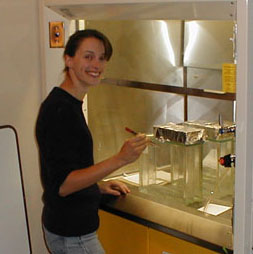
Andrea Ruchty studied riparian lichens in the Coast Range of Oregon, finishing her master's thesis in 2000. In particular, how do different canopy types influence epiphytic lichens? She also worked with Abbey Rosso and Bruce McCune on the dynamics of shrub epiphytes. Like her namesake, the moss Andreaea, she is tenacious in demanding environments. She is field-certified in macrolichens west of the Cascade Crest by Northwest Lichenologists. Andrea currently works for the Gifford-Pinchot Nationial Forest in Washington.
Sillett, S. C., B. McCune, J. E. Peck, T. R. Rambo, and A. Ruchty. 1999. Dispersal limitations of epiphytic lichens result in species dependent on old-growth forests. Ecological Applications 10:789-799.
Ruchty, A. M. 2000. The association of epiphytic macrolichens and bryophytes with riparian stand types along a valley continuum, Oregon Coast Range. MS Thesis, Oregon State University. 109 pages.
Ruchty, A. M., A. L. Rosso, & B. McCune. 2001. Changes in epiphyte communities as the shrub, Acer circinatum, develops and ages. Bryologist 104:274-281.
Ruchty, A. M. & B. McCune. 2001. The association of epiphytic macrolichens and bryophytes with riparian stand types along a valley continuum, Oregon Coast Range. manuscript.
Ruchty, A. M. & B. McCune. 2001. Is lichen growth linked to canopy composition? A transplant experiment. manuscript.
Ruchty, A. M. & B. McCune. 2001. The association of epiphytic macrolichens and bryophytes with riparian stand types along a valley continuum, Oregon Coast Range. manuscript.
Sillett, S. C., B. McCune, J. E. Peck, T. R. Rambo, and A. Ruchty. 1999. Dispersal limitations of epiphytic lichens result in species dependent on old-growth forests. Ecological Applications 10:789-799.
Ruchty, A. M. 2000. The association of epiphytic macrolichens and bryophytes with riparian stand types along a valley continuum, Oregon Coast Range. MS Thesis, Oregon State University. 109 pages.
Ruchty, A. M., A. L. Rosso, & B. McCune. 2001. Changes in epiphyte communities as the shrub, Acer circinatum, develops and ages. Bryologist 104:274-281.
Ruchty, A. M. & B. McCune. 2001. The association of epiphytic macrolichens and bryophytes with riparian stand types along a valley continuum, Oregon Coast Range. manuscript.
Ruchty, A. M. & B. McCune. 2001. Is lichen growth linked to canopy composition? A transplant experiment. manuscript.
Ruchty, A. M. & B. McCune. 2001. The association of epiphytic macrolichens and bryophytes with riparian stand types along a valley continuum, Oregon Coast Range. manuscript.
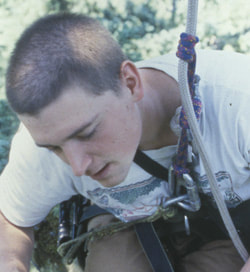
Steve Sillett developed his love of tree climbing and his passion for science into numerous projects having to do with tree architecture, forest age, and the organisms that compose and inhabit the canopy. In addition to his PhD project at OSU, Steve was instrumental in a study that demonstrated the importance of dispersal limitation as a cause for old-growth association of lichens. Steve finished his Ph.D. in 1995 and has since been employed on the faculty of Humboldt State University, Arcata, California. Steve is currently the Fisher Chair in Redwood Ecology and Professor in the Department of Forestry and Wildland Resources at Humboldt State University. Please see Steve's website.
Sillett, S. C. 1994. Growth rates of two epiphytic cyanolichen species at the edge and in the interior of a 700-year-old Douglas fir forest in the western Cascades of Oregon. Bryologist 97:321-324.
Sillett, S. C. 1995. Branch epiphyte assemblages in the forest interior and on clearcut edge of a 700-year old Douglas Fir canopy in western Oregon. Bryologist 98:301-312.
Sillett, S. C. 1995. Canopy epiphyte studies in the central Oregon Cascades: implications for the management of Douglas-fir forests. Ph.D. Dissertation.
Sillett, S. C. and P. N. Neitlich. 1996. Emerging themes in epiphyte research in westside forests with special reference to cyanolichens. Northwest Science 70:54-60.
McCune, B., C. C. Derr, P. S. Muir, A. Shirazi, S. C. Sillett, and W. J. Daly. 1996. Lichen pendants for transplant and growth experiments. Lichenologist 28:161-169.
Sillett, S. C. & T. Goward. 1998. Ecology and conservation of Pseudocyphellaria rainierensis, a Pacific Northwest endemic lichen. Pages 377-388 in M. G. Glenn, R. C. Harris, R. Dirig, & M. S. Cole, editors, Lichenographa Thomsoniana: North American lichenology in honor of John W. Thomson. Mycotaxon, Ithaca, New York, USA.
Sillett, S. C. & B. McCune. 1998. Survival and growth of cyanolichen transplants in Douglas-fir forest canopies. Bryologist 101:21-31.
Sillett, S. C. & M. N. Goslin. 1999. Distribution of epiphytic macrolichens in relation to remnant trees in a multiple-age Douglas-fir forest. Canadian Journal of Forest Research 29:1204-1215.
Sillett, S. C. and T. R. Rambo. 2000. Vertical distribution of dominant epiphytes in Douglas-fir forests of the central Oregon Cascades. Northwest Science 74:44-49.
Sillett, S. C., B. McCune, J. E. Peck, T. R. Rambo, and A. Ruchty. 2000. Dispersal limitations of epiphytic lichens result in species dependent on old-growth forests. Ecological Applications 10:789-799.
Sillett, S. C., B. McCune, J. E. Peck, & T. R. Rambo. 2000. Four years of epiphyte colonization in Douglas-fir forest canopies. Bryologist 103:661-669.
[See further publications at Google Scholar.]
Sillett, S. C. 1994. Growth rates of two epiphytic cyanolichen species at the edge and in the interior of a 700-year-old Douglas fir forest in the western Cascades of Oregon. Bryologist 97:321-324.
Sillett, S. C. 1995. Branch epiphyte assemblages in the forest interior and on clearcut edge of a 700-year old Douglas Fir canopy in western Oregon. Bryologist 98:301-312.
Sillett, S. C. 1995. Canopy epiphyte studies in the central Oregon Cascades: implications for the management of Douglas-fir forests. Ph.D. Dissertation.
Sillett, S. C. and P. N. Neitlich. 1996. Emerging themes in epiphyte research in westside forests with special reference to cyanolichens. Northwest Science 70:54-60.
McCune, B., C. C. Derr, P. S. Muir, A. Shirazi, S. C. Sillett, and W. J. Daly. 1996. Lichen pendants for transplant and growth experiments. Lichenologist 28:161-169.
Sillett, S. C. & T. Goward. 1998. Ecology and conservation of Pseudocyphellaria rainierensis, a Pacific Northwest endemic lichen. Pages 377-388 in M. G. Glenn, R. C. Harris, R. Dirig, & M. S. Cole, editors, Lichenographa Thomsoniana: North American lichenology in honor of John W. Thomson. Mycotaxon, Ithaca, New York, USA.
Sillett, S. C. & B. McCune. 1998. Survival and growth of cyanolichen transplants in Douglas-fir forest canopies. Bryologist 101:21-31.
Sillett, S. C. & M. N. Goslin. 1999. Distribution of epiphytic macrolichens in relation to remnant trees in a multiple-age Douglas-fir forest. Canadian Journal of Forest Research 29:1204-1215.
Sillett, S. C. and T. R. Rambo. 2000. Vertical distribution of dominant epiphytes in Douglas-fir forests of the central Oregon Cascades. Northwest Science 74:44-49.
Sillett, S. C., B. McCune, J. E. Peck, T. R. Rambo, and A. Ruchty. 2000. Dispersal limitations of epiphytic lichens result in species dependent on old-growth forests. Ecological Applications 10:789-799.
Sillett, S. C., B. McCune, J. E. Peck, & T. R. Rambo. 2000. Four years of epiphyte colonization in Douglas-fir forest canopies. Bryologist 103:661-669.
[See further publications at Google Scholar.]
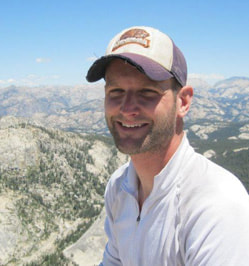
Robert J. Smith obtained his bachelor's degree from OSU, then circled back to us via Lloyd Stark's lab in Nevada and the Forest Service in eastern Oregon. In the meantime he obtained a masters working on the ecology of desert mosses. For his Phd Rob worked on various projects, but especially work on continental-scale gradients related to lichen distribution and abundance in relation to climate. He also was an integral part of a group developing rapid and efficient methods for estimating biomass of functional groups in the ground layer (lichens and bryophytes), as part of the Forest Inventory and Analysis program, such that their contributions to carbon storage, diversity, and cover can be estimated. See Rob's website for a complete list of his publications. Rob completed his PhD in 2017, followed by a postdoc working with the Forest Service out of the Portland FIA office in cooperation with our group at OSU. Find his current details at https://www.rsmithlab.org/
Smith, R. J., P. R. Nelson, S. Jovan, P. J. Hanson and B. McCune. 2018. Novel climates reverse carbon uptake of atmospherically dependent epiphytes: Climatic constraints on the iconic boreal forest lichen Evernia mesomorpha. American Journal of Botany 105:1–9.
Smith, R. J., S. Jovan & B. McCune. 2017. Lichen communities as climate indicators in the U.S. Pacific States. General Technical Report PNW-GTR-952. USDA Forest Service, Pacific Northwest Research Station, Portland, Oregon. 44 pages.
Smith, R. J., S. Jovan, A. N. Gray, and B. McCune. 2017. Sensitivity of carbon stores in boreal forest moss mats: effects of vegetation, topography and climate. Plant and Soil 421:31–42.
Smith, R. J. 2017. Realized and potential climate responses of lichen and bryophyte communities in a national forest inventory. PhD Dissertation, Oregon State University.
Smith, R. J. 2017. Solutions for loss of information in high-beta-diversity community data. Methods in Ecology and Evolution 8: 68–74.
Calabria, L. M., K. Petersen, S. Hamman and R. J. Smith. 2016. Prescribed fire decreases lichen and bryophyte biomass and alters functional group composition in Pacific Northwest prairies. Northwest Science 90: 470–483.
Smith, R. J., J. C. Benavides, S. Jovan, M. Amacher & B. McCune. 2015. A rapid method for landscape assessment of carbon storage and ecosystem function in moss and lichen ground layers. Bryologist 118:32-45. doi: http://dx.doi.org/10.1639/0007-2745-118.1.032
Smith, R. J. and J. H. Rausch. 2015. Bryophytes and lichens from Malheur National Forest, Blue Mountains of eastern Oregon. Evansia 32:78-96.
Smith, R. J., E. Alphandary, R. Arvidson, G. Bono, B. Chipman, A. Corkery, J. Di Meglio, K. Hansen, K. Isch, J. McAlpine, C. Marks-Fife, B. Mead, D. Miller, N. Nolte, A. Ottombrino, T. Prior, J. Streich, S. Theis, S. Vandruff, C. Wesseler, K. Wesseler, M. Wiseman & B. McCune. 2012. Rare inland reindeer lichens at Mima Mounds in southwest Washington State. North American Fungi 7(3): 1-25.
[See further publications at Google Scholar.]
Smith, R. J., P. R. Nelson, S. Jovan, P. J. Hanson and B. McCune. 2018. Novel climates reverse carbon uptake of atmospherically dependent epiphytes: Climatic constraints on the iconic boreal forest lichen Evernia mesomorpha. American Journal of Botany 105:1–9.
Smith, R. J., S. Jovan & B. McCune. 2017. Lichen communities as climate indicators in the U.S. Pacific States. General Technical Report PNW-GTR-952. USDA Forest Service, Pacific Northwest Research Station, Portland, Oregon. 44 pages.
Smith, R. J., S. Jovan, A. N. Gray, and B. McCune. 2017. Sensitivity of carbon stores in boreal forest moss mats: effects of vegetation, topography and climate. Plant and Soil 421:31–42.
Smith, R. J. 2017. Realized and potential climate responses of lichen and bryophyte communities in a national forest inventory. PhD Dissertation, Oregon State University.
Smith, R. J. 2017. Solutions for loss of information in high-beta-diversity community data. Methods in Ecology and Evolution 8: 68–74.
Calabria, L. M., K. Petersen, S. Hamman and R. J. Smith. 2016. Prescribed fire decreases lichen and bryophyte biomass and alters functional group composition in Pacific Northwest prairies. Northwest Science 90: 470–483.
Smith, R. J., J. C. Benavides, S. Jovan, M. Amacher & B. McCune. 2015. A rapid method for landscape assessment of carbon storage and ecosystem function in moss and lichen ground layers. Bryologist 118:32-45. doi: http://dx.doi.org/10.1639/0007-2745-118.1.032
Smith, R. J. and J. H. Rausch. 2015. Bryophytes and lichens from Malheur National Forest, Blue Mountains of eastern Oregon. Evansia 32:78-96.
Smith, R. J., E. Alphandary, R. Arvidson, G. Bono, B. Chipman, A. Corkery, J. Di Meglio, K. Hansen, K. Isch, J. McAlpine, C. Marks-Fife, B. Mead, D. Miller, N. Nolte, A. Ottombrino, T. Prior, J. Streich, S. Theis, S. Vandruff, C. Wesseler, K. Wesseler, M. Wiseman & B. McCune. 2012. Rare inland reindeer lichens at Mima Mounds in southwest Washington State. North American Fungi 7(3): 1-25.
[See further publications at Google Scholar.]
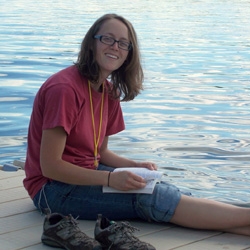
Kaleigh Spickerman hails from the wilds of northern Wisconsin. She
completed her undergraduate degree at the University of Wisconsin - Eau Claire,
where she distinguished herself by student projects on lichen communities and
functional traits of flowering plants. At OSU she is working on lichens of
Katmai National Park in Alaska, with special emphasis on how functional traits
and functional groups of lichens differentiate along environmental and
disturbance gradients.
Spickerman, K. 2015. Lichen Functional Trait Variation Along an East-West Climatic Gradient in Oregon and Among Habitats in Katmai National Park, Alaska. MS Thesis, Oregon State University. 109 pages.
completed her undergraduate degree at the University of Wisconsin - Eau Claire,
where she distinguished herself by student projects on lichen communities and
functional traits of flowering plants. At OSU she is working on lichens of
Katmai National Park in Alaska, with special emphasis on how functional traits
and functional groups of lichens differentiate along environmental and
disturbance gradients.
Spickerman, K. 2015. Lichen Functional Trait Variation Along an East-West Climatic Gradient in Oregon and Among Habitats in Katmai National Park, Alaska. MS Thesis, Oregon State University. 109 pages.
